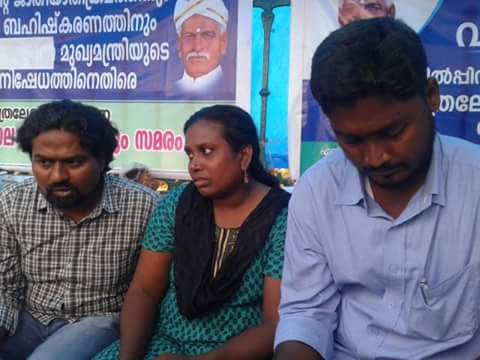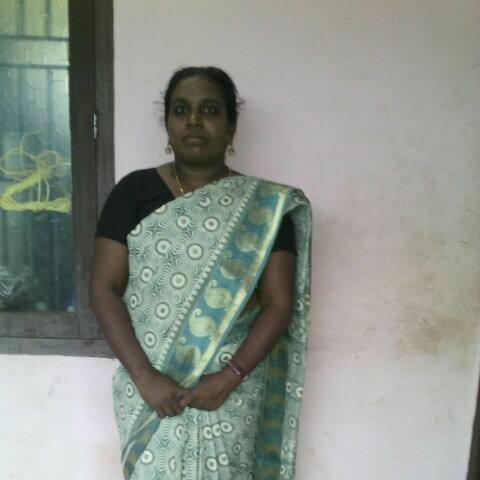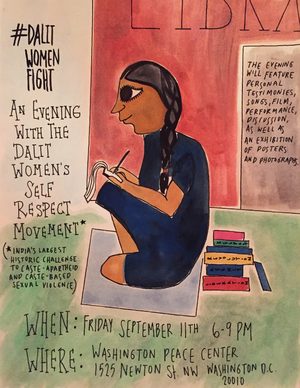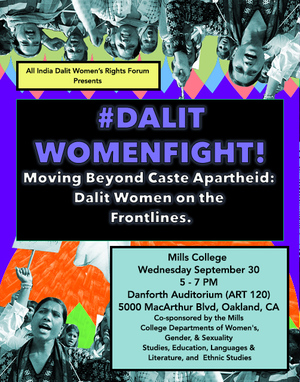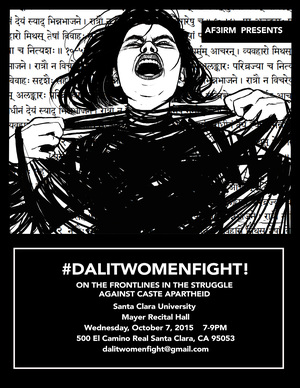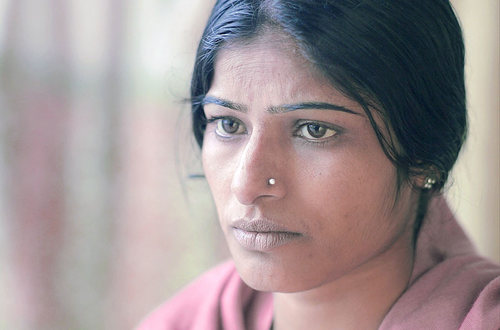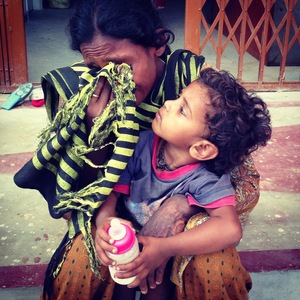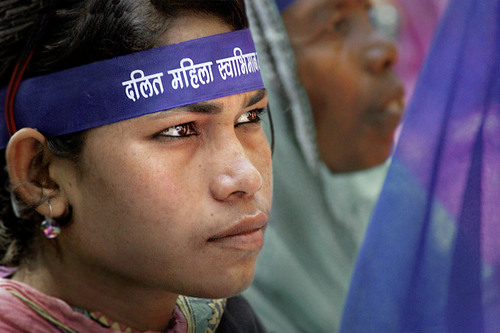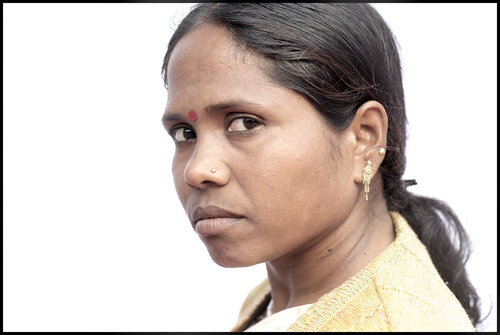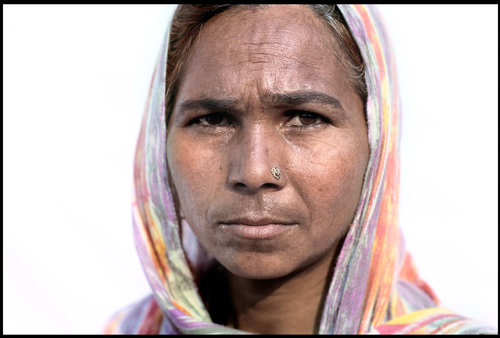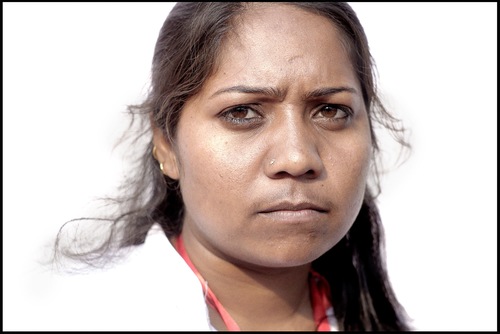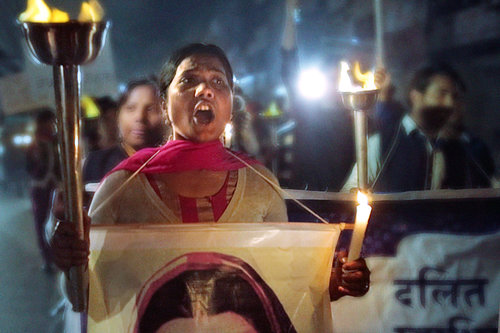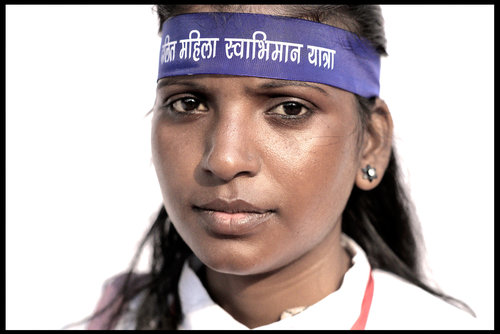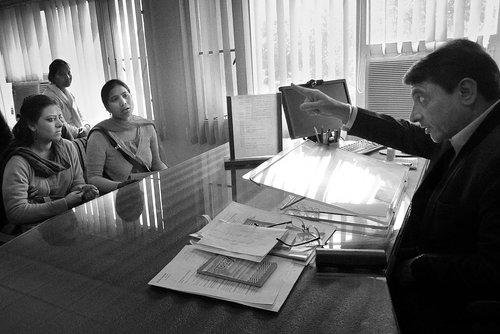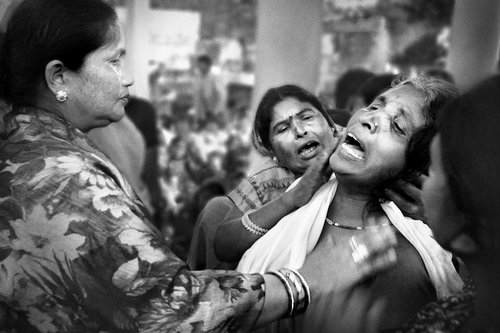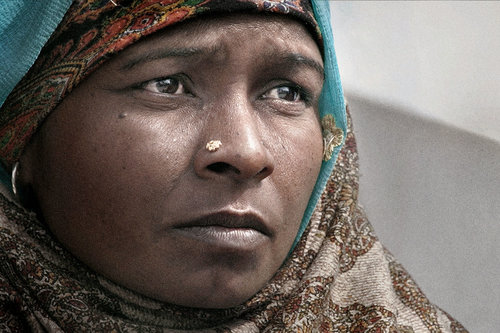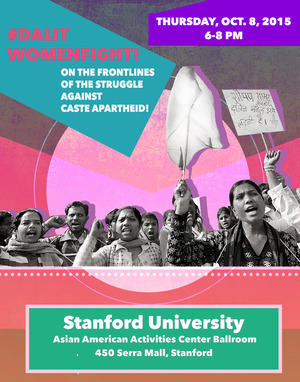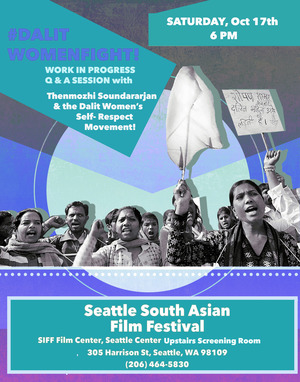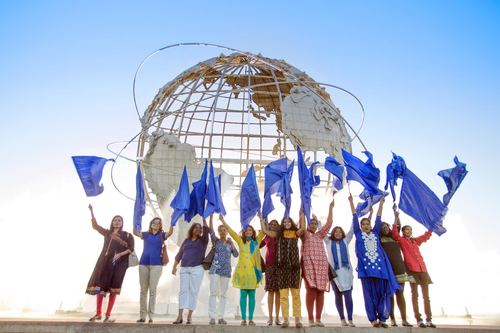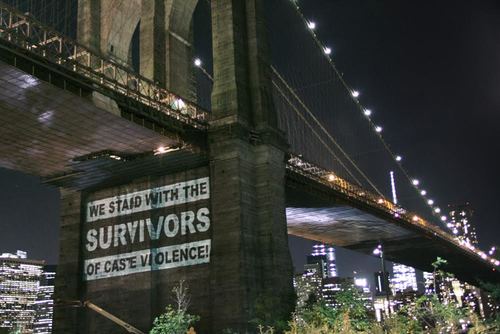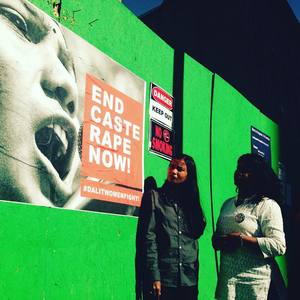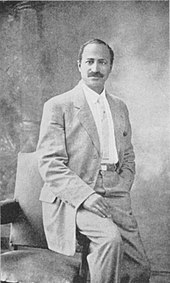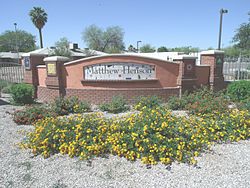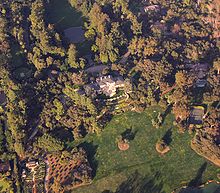Abhiram Ghadyalpatil
Poet and Dalit activist Pradnya Daya Pawar on the historical and contemporary Dalit concerns, victimization of Dalit women, literature as the weapon of Dalit activism, and the contemporary social, cultural and political climate
Mumbai: When poetry is a conscious act of rebellion, words become weapons of mass uprising. For Pradnya Daya Pawar, the idea of revolt comes from her middle name. Baluta, her father Daya Pawar’s autobiography in Marathi published in 1978, was one of the first personal accounts of a Dalit that soon became a genre in Dalit literature. In 2015, Mumbai-based writer Jerry Pinto translated Baluta into English. Between 1978 and 2018, the literary grammar of Dalit expression, anger and protest went from being a novelty to becoming the norm.
Pradnya Pawar, who to her credit has five anthologies packed full of searing Dalit anger and feminist overtones, is the representative of this transition that still maintains its connect with its poignant past. “The volcano was there in dada’s (her father) writings; the volcano is still right in here. Only his expression was different," the poet, activist and feminist says in an interview ahead of Babasaheb Ambedkar’s birth anniversary on 14 April. Edited excerpts:
Your poetry has a distinctly feminist personality and angst. Where does this anger come from? How does one contextualize the feminine character of your expression?
The anger comes from my own experiences as a Dalit girl, woman and a professional, as well as from what I see happening around me. I grew up in the social and political milieu reverberating with the angry rebellion of the Dalit Panther movement in Maharashtra. The entire Marathwada region and to some extent other parts of Maharashtra were simmering with the demand to rename the Marathwada University after Babasaheb Ambedkar.
Through my father and his associates, I had an immediate exposure to these issues. I was a school-going child but I absorbed whatever I could. And there were Dalit writers, early feminists, who wrote about the atrocities against Dalits, particularly Dalit women. That expression of heartfelt anger became part of my being and has stayed with me.
What I have experienced and seen happen to women, and not only Dalit women, is what has been the historical truth—that it is the women who are the most vulnerable targets of oppression, atrocities, wars, political movements and all such acts of organized mobilization.
From the two women victims in Khairlanji, Maharashtra, in 2006 to the Unnao rape victim (in Uttar Pradesh where a Bharatiya Janata Party legislator has been charged with rape) to the eight-year-old girl in Kathua, Jammu and Kashmir, who was gang-raped and murdered, it is the women who bear the brunt of atrocities. This violence against women has many layers. In Khairlanji, it was because they were Dalits. The Kathua girl was picked up because she was a Muslim. But the Unnao victim is a Hindu. Why was she picked up? Because the men who preside over this system consider women as their personal property to be exploited at their will. The severity of my personal, social, cultural and political experiences as a woman has only sharpened. How can my poetry remain mute when the rape and murder accused of an eight-year-old are defended?
But isn’t the issue of victimization of women much more nuanced? Even within the communities and castes that are at the receiving end of violence and injustice for what they are, their own women are discriminated against. This holds true for Dalit women or Muslim women or even Brahmin women.
Absolutely. In fact, a Dalit woman experiences multiple layers of victimization and discrimination. And it applies to Dalit women irrespective of their social, intellectual and economic standing. I have been a professor for 28 years and I have experienced these multiple layers of discrimination as a Dalit person, as a woman and as a Dalit woman!
Ironically, several men from among Dalits who call themselves progressive and reformist, and many of them are so indeed, have perpetrated this kind of gender discrimination. There have been other Dalit women writers who have experienced this and written about it. Woman, as a gender, faces multiple threats at the macro and micro levels. Globalization represents the macro-level threat when woman has become an economic commodity to be exploited by the capitalist forces. Within societies and communities and castes down the line, this objectification assumes social, communal, cultural, and personal connotations and angularities. The poetry that I write or others of my ilk write is in fact an attempt to put together a collage of these complexities.
You are a second-generation activist and writer who has consciously and instinctively deployed the medium of writing as a weapon of self-actualization as well as social cause. Do you think the issues and the society your father wrote about have undergone a positive change?
Whether or not the society has undergone a positive change depends on the location we are talking about. At the macro level, the caste system that my father wrote about does not exist 100% as it did during his time. But if you are living in a village or small town, then caste is a reality like it was. Also, there is another way by which caste has staged a comeback.
The economic concerns born out of globalization and ascendance of capitalism are accentuating the caste and communal identities, and people are coming together along caste lines to either hold on to their economic benefits or demand economic benefits. For instance, the Maratha caste mobilization for quota. Caste continues to operate at multiple levels. In the India of 2018, there are 564 villages where lower castes are not allowed to take water from public taps and public places, and they must not be seen in public wearing new clothes. A lower-caste couple in Uttar Pradesh had to fight for their wedding procession to pass through Thakur-dominated parts. And they are not even Dalit or Buddhist. They are a Hindu caste. A young Dalit was killed in Gujarat because he rode a horse. These are manifestations of caste.
Do you agree with the recent Supreme Court order that the Scheduled Castes and the Scheduled Tribes (Prevention of Atrocities) Act is much abused?
There are ways to look at this Act, the context in which it was made and the very reasons for caste-based reservations. The Act was introduced because the SC/STs (Scheduled Castes and the Scheduled Tribes) were rightly acknowledged as the weaker communities deserving of protection. The reservations were enshrined in the Constitution because they were rightly thought to be well-deserved.
Sadly, the Supreme Court has apparently not situated its order and observations in this context. There is well-documented evidence that the Act is not used in the first place for the purposes it has been put in place. In 2016, of the total cases of atrocities against the SCs, 89.6% were pending settlement at various stages. This proportion was 87% for cases registered by the STs. This means the Act is not being used as effectively as it should be, so how does the question of misuse arise? Unfortunately, there is an ongoing infantilization of the SC/STs in which the Supreme Court has also perhaps unwittingly participated by observing that the SC and ST allow the Act to be abused and that they don’t know how to use it.
You have been a critic of the Congress regime too. What differentiates the BJP regime from the previous dispensation in terms of their respective approaches to Dalits?
There isn’t much of a difference in approach. But today’s social, cultural and political climate is way different from what it was 20 years back.
I have frequently criticized the Congress party and its politics from public platforms in the presence of Congress leaders. They would at least listen. In today’s climate, I am made to fear for myself, for my children, if I choose to speak my mind. When I returned my awards in 2016, it was a protest against this climate which, sadly, gets sanction from the very top. I, and many of my women friends, were branded Naxals even when we protested against the Khairlanji killings.
But today, in addition to being branded, one is directly attacked. There is definitely a very real and fearful climate that harbours ill-will against minorities, Dalits, women and even students who choose to think differently. What happened with Rohith Vemula or what is happening at the Tata Institute of Social Sciences in Mumbai represents an attempt to deny even education and upward mobility to the weaker sections.
How do you look at the politics prosecuted by parties formed in the name of Dalits and supposedly espousing the Dalit cause?
Some five years back, I was among those critics of established Dalit politics who would dismiss the big and small Dalit parties and splinter groups as corrupt parties co-opted either by the Congress or BJP. In the first place, I never had any hopes from political parties that claimed to represent only Dalits. Because parties which claim to represent only one particular caste or group or community tend to get stuck in the politics of identity. They become prisoners of their identities. Babasaheb Ambedkar never believed in this kind of politics.
But what is happening now gives people like me a lot of hope. The way a young politician like Jignesh Mevani (Gujarat MLA) is trying to base his politics on the coalition of Dalits, OBCs (Other Backward Classes), farmers, labourers and women, is a welcome change. There is hope even in the new course of politics that established leaders like Prakash Ambedkar are practising now.
People like Mevani and Ambedkar have identified the common enemy of Dalits, farmers, students, women, labourers, as being one, and they are fighting that enemy. What is most remarkable is that the theoretical and ideological exposition of the caste system that Babasaheb made in his Annihilation of Caste in 1936 has now been acknowledged and become part of the national discourse.
Bezwada Wilson
Wilson, himself a Dalit, has vehemently campaigned against the inhuman practice of manual scavenging. He has played a role in saving and helping rehabilitate 3 lakh manual scavengers. He comes from a Dalit family in Kolar who were involved in manual scavenging for generations. He is the national convenor of Safai Karmchari Andolan. He also got a Supreme Court judgment to his credit which directed all States and UTs to provide compensation to families of people who died cleaning sewers. He is a recipient of the prestigious Ramon Magsaysay award.
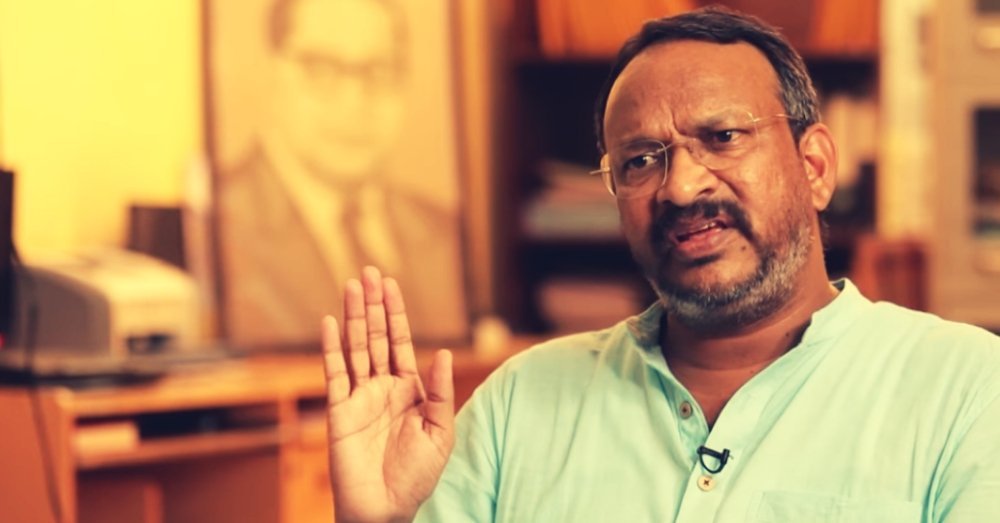
(Image Courtesy: Youth Ki Awaaz)
He was pivotal in getting the Kolar Gold Mines to demolish dry latrines which had to be cleaned by people from his community, including his father and brother. Speaking about the beginning of his journey of caste consciousness, he said, “For the first time, I understood that we are scavengers not because we are illiterate or poor but because we are born into a caste. I started relating all my personal experiences to this history of my people."
Chendroo
Know who was Bastar's real Mogli world famous "Cindu the Tiger Bye"
by Gondwana Express

Shakuntala Dushyant's son Bharat played with lions in childhood, just like this boy from Bastar played with lions. The boy's name was Chendroo. Cheduru the Tiger Bay, famously known as Chendro Puri, was not less than any Aju for the world. The famous 'Chhadaru Puri', popularly known as Bastar Mowgli, was famous in the world in the 60's. The interesting aspect of the life of Chendro was his friendship with Tiger, that too of the real forest. Friendships were such that both of them always lived together, eating, playing, sleeping together all together.
Chendru, who was called Real Mowgli of Bastar, had said goodbye to the world in 2013. Sixty years ago, Chenduru had drawn attention from around the world. People from France, Sweden, Britain and people from all corners of the world used to see a glimpse of only one, to capture one of their photographs in their camera to Bastar. Cheduru Mandavi of Maria tribe of Bastar became famous all over the world as Tiger Boy and Real Mowgli.
Chandaru was a resident of Narayanpur.

Cedaru Mandavi was a resident of Narangpur's Backyard Bengal. This boy from Muria tribe was very brave. Once in his childhood grandfather brought a lion cub from the forest. She named him Temba. Both of them had a strong friendship. Together they used to eat, walk and play together. The information about the friendship of these two people gradually spread to the whole world. Sweden's Oscar Winner film director Arne Saxdorf arrived in Bastar with the thought of making a film on Cheduru and with complete preparation.
This child was caught by the sight of Swedish director Arne Sucksdorff, who visited Buxar in Ghughharghasurrounded by dense forests . In the jungle, with the lions, the friendly friendship director was so worried that they did not stay. Then there was a film "The Jungle Saga" in which the lead roll was on Bastar's "Tiger Boy" Chendroi.
As soon as the film was released, Chendru had become a Hollywood star overnight

In 1957, the song 'N the Jungal Saga ( En djungelsaga )' was made in Swedish : The Flute and the Arrow , a Swedish film made on the country's recognition of Bastar abroad, along with his friend Tiger Friendship was shown about. He played the hero of this movie and stayed here and completed shooting in two years. This film made him famous all over the world. In this film, Ravi Shankar gave the music, Ravi Shankar was struggling to make his identity and at that time he was known as the musician of Chendroo.
Director Arne Saxdorf wanted to adopt Chadurdu
Cheduru wanted to adopt Arne Saksdorf, but due to his divorce from his wife Astrid Bergman Sucksdorff , it was not possible to do so. Astrid was a successful photographer as well as a writer. At the time of the shooting of the film, he shot several pictures of Chadru and wrote a book called ' Chendru: The Boy and the Tiger ' on the Chendro .
After that Chandur returned to India, then the then Prime Minister Jawaharlal Nehruji advised to stop Chendro from Mumbai. But away from the life of the crowd and on the father's call, he returned to his home in Bastar.
In the absence of anonymity and living life
Chadrupu, who had become accustomed to living in glare glamor, remained in a deserted place in the village. Where their life was spent in the absence of absence. When the youth of Khedor's age came back to the village from the foreign country, then there was a ground truth in front of them. Over time, Chenduru went missing in the forest of Narayanpur and Bastar. When Chamduru returned from abroad, he was separated from the village for many years.
It was at one time that the world of anonymity was completely lost, which some journalists discovered in the 90s. Instead of working in the film, he got only two rupees for the day. In 2013, this anonymous hero died due to a long illness.
Chendro was very happy person
Like any other Muriya tribal, Chendru is very happy and will not care about many things. But in front of Chenduru, his past comes up, like a dream, perhaps he can not be freed.
According to Jairam Mandavi, son of Chenduru, if his father received financial help, then his condition might not have been so. Jairam says, "When Dad fell ill, a Japanese woman helped Rs 1.5 lakh. Apart from this, a minister from Chhattisgarh gave Rs 25 thousand rupees but before and after this nobody has asked us.

In memory of this brilliant glory of Bastar, the Chhattisgarh government has given a true tribute by making a memorial of Chendru in the jungle safari of Raipur.
Chitralekha
Dalit auto-rickshaw driver battling CPM-led caste oppression in Kerala
Chitralekha, born into a Dalit family, raised eyebrows when she married Srishkant, a higher caste Thiyya man, and decided to earn her living by driving an auto-rickshaw in Payyannur town of Kannur district
The CPM-led Left government in Kerala, which came into power in 2016, will particularly be noted for two things: First is the constant criticism over political violence between the CPM and RSS, and the subsequent political deliberation by the BJP's central leadership. And secondly, repeated instances of caste-based discrimination in the state.
Instances of the caste-based violence and discrimination have surfaced from many different parts of the state. An inter-caste marriage, the subsequent unrest in Palakkad district's Ambedkar Colony, and the custodial torture of a Dalit teen leading to his suicide in Thrissur district are some of the recent examples.
These stories hit the news media consumed by the middle class before suffering a slow death and leaving the caste reality behind. Meanwhile, government and political parties move ahead with their development agendas.
There, however, is one woman, Chitralekha, who has dared the CPM and fought relentlessly for 14 years to assert her dignity and seek justice. Chitralekha's story bares the casteist and sexist face of the so-called progressive party and state. She has made headlines in the national media for her indomitable struggle against the CPM. Even when the media and authorities turned her down after the initial curiosity fizzled, she continued her struggle unrelentingly. When she staged a 47-day sit-in protest in front of the secretariat in the state capital, the banner read 'Against the casteist attacks of CPM'.
Chitralekha. Firstpost/Akhil Vasudevan
Chitralekha, born into a Dalit family, raised eyebrows when she married Srishkant, a higher caste Thiyya man. In 2004, she decided to earn her living by driving an auto-rickshaw in Payyannur town of Kannur district. Her decision aggravated the intolerance among the male auto drivers, many of whom hail from the upper castes. Chitralekha and her family suffered multiple physical attacks by the male auto-drivers in the region who are part of the CITU, the trade union outfit belonging to the CPM.
She survived a murder attack, her auto was set on fire, and her brother-in-law was slashed while trying to save her husband from an attack. The CPM continued to dismiss her story as a local issue and never condemned the violence against her, and never even moved to keep its local cadre under control.
After these attacks against her continued for over a decade, Chitralekha went on a 122-day protest in 2014 in front of the district collectorate seeking protection. The Congress government of Oommen Chandy had assured her of support and rehabilitation in another town within the district. The Chandy government also promised her land and financial assistance to build a house on it.
But after the CPM regained power in 2016, the party took out a rally against her, and even denied the financial assistance promised to her by the previous government and was put on hold by bureaucrats. The CPM formed a 'Landless Homeless Action Committee' against Chitralekha, claiming the Congress government sanctioned land illegally. They wanted the land allocated to her to be redistributed among other landless Dalits.
According to the Rajamanikyam Report, about 5 lakh acres of land is held illegally by corporates in Kerala's Munnar hills. But the CPM has never taken out a rally like this against them, never demanded this land be confiscated and be redistributed among the state's plantation workers, landless Dalits and tribals.
"They couldn't afford to have me in their space, since I am a Dalit woman," says Chitralekha.
But while the party's failure to address this issue is of concern, it's not surprising. It should be noted that the party doesn't consider it as a petty fight between auto drivers. In 2010, a fact-finding team of academicians and lawyers met Chitralekha to release a report, but the party "unofficially" denied them permission. The team later presented the report in the neighbouring district of Kozhikode.
Though the CPM has projected itself as a champion of the anti-caste struggle in the state and in different university campuses across India, it has ignored narratives of caste discrimination where party members or leaders are involved.
Several Left governments in the state have made repeated attempts to cover their inability to tackle the caste reality. They even launched a state-wide celebration of the centenary anniversary of the 'nammuku jathiyilla' (I have no caste) proclamation made by Sree Narayana Guru. But given the record of being perpetrators in many caste-based violence cases, these futile efforts only protrude the party's double standards.
For many from the party intelligentsia, Chitralekha's issue is a local one, which can be settled if party leaders give a strict warning to their cadre in Kannur. But Chitralekha thinks otherwise. "They might be able to stop the attacks. If the party leaders tell the cadre to put an end to this, it may end. But caste is a different condition altogether. They cannot end the condition which is created due to caste," she rued.
The CPM has denied Chitralekha's allegations and the party isn't involved in the case at all. TV Rajesh, the MLA from Kalyassery, said, "I understand that she had some issues with her neighbours and a few others in the region, but the CPM is not involved in the case. I think there are people conspiring against the party and trying to tarnish its name. But CPM is a party which stands for the rights of all humans, and we stand with everyone including Chitralekha."
Rajesh also said he is unaware of the party withdrawing any financial assistance made to Chitralekha by the previous government.
The CPM and its allies are spearheading the fight against BJP's fascist politics in the country, and the Pinarayi Vijayan government makes national headlines for its daring moves against the BJP. But for Chitralekha, the CPM is fascist in its own right. "Without understanding that caste violence is the highest form of fascism in the Indian context, what anti-fascist unity are they going to do.
The 39-year-old lady told Twocirles.net that she saw CPI (M) worker Abhilash damaging her auto rickshaw but he ran away by the time she came of the house at Edat in Payyannur.
“I saw Abhilash and two others when I looked through window,” she alleged. Chitralekha became the target of local CPI (M) leadership as she married a man belonging to Thiyya caste, which claims the higher ranking in the Hindu caste system. “Ever since I began to work as an auto rickshaw driver to earn my food in 2004, I have been facing threats from the CPI (M) activists. When I arrived in an auto rickshaw-stand affiliated to the CITU (the CPI (M) affiliated trade union), I was welcomed by caste slurs.
They asked me ‘what the hell is a Pulaya lady is doing with our auto rickshaw stand?’
Pulaya caste members were the slaves of feudal landlords in Malabar.
The auto rickshaw, according to Chitralekha, needed repair of Rs. 20,000 as its seat and cover were completely torn.
Payyannur police confirmed that Chithralekha had filed a complaint, saying her vehicle had been damaged. “The roof and seat of the vehicle had been damaged with blade,” the police said
After staging protests in front of the Kannur collectorate and the state secretariat for the last few years, the government recently allocated her five cent land at Kattambally in order to relocate her from Edat owing to repeated attacks. The land was given following 122 days dharna in front of Kannur collectorate and 20 days protest in front of the Secretariat in Thiruvananthapuram. On March 4, she was visiting her house at Edat to collect documents for one of the several cases in court, which had been filed during these years due to the harassment.
“They were not able accept a woman auto driver, who is a Dalit woman, was doing the same job they do. Since then, they have been torturing me. In December, 2005 they burned my auto rickshaw. Still, they are taking up efforts to lower my morale by describing me as a woman, who drinks and doesn’t know how to behave,” she added.
However, the latest attack is unlikely to dent her confidence: “I am not ready to bow my head and continue to fight back,” she said.
Meanwhile, the continuing assault on the Dalit lady has drawn the ire of the activists and Dalit organisations in Kerala.
“Chithralekha’s case has brought the attitude of CPI (M), which claims to be the protectors of Dalits, to the light. The attacks could be easily brought to an end if the party leaders interfere in the issue. But, despite repeated pleas and protests the party leadership is turning a blind eye towards her woes,” said Dalit activist AS Ajith Kumar.
However, Chithralekha is pinning hope on the district administration as she has given a detailed complaint to the district collector P Balakiran seeking steps to end the assault on her.
DALIT WOMEN FIGHT
2015 NORTH AMERICAN TOUR
THE DALIT WOMEN'S SELF-RESPECT MARCH/DALIT MAHILA SWABIHMAAN YATRA IS THE LARGEST HISTORIC CHALLENGE TO CASTE-BASED SEXUAL VIOLENCE IN INDIAN HISTORY.
THE BRAINCHILD OF THE ALL INDIA DALIT WOMEN'S RIGHTS FORUM/ALL INDIA DALIT MAHILA ADHIKAAR MANCH, SURVIVORS AND ACTIVISTS TOOK TO MARCHING ACROSS INDIA TO CALL OUT THE SYSTEMIC FAILURE OF THE INDIAN GOVERNMENT TO PROTECT DALIT WOMEN AND THEIR FAMILIES.
THIS MARCH NOW COMES TO NORTH AMERICA. OUR GOAL IS TO BREAK THE SILENCE ON CASTE APARTHEID AND CASTE RAPE WHILE ALSO STANDING SHOULDER TO SHOULDER WITH OTHER WOMEN BREAKING THE SILENCE ON STATE VIOLENCE ALL ACROSS THE US.
WE WILL HAVE MANY STRATEGIES SO CHECK BACK ON THIS PAGE OFTEN.
WE ALSO ENCOURAGE YOU TO CHECK OUT OUR GALLERY OF ART AND PHOTOGRAPHY THAT IS GROWING THROUGH OUR TOUR. IF YOU WOULD LIKE TO SUBMIT ART PLEASE CONTACT US AT DALITWOMENFIGHT@GMAIL.COM.
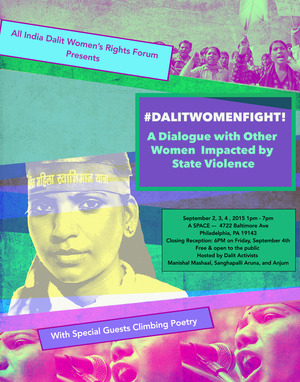


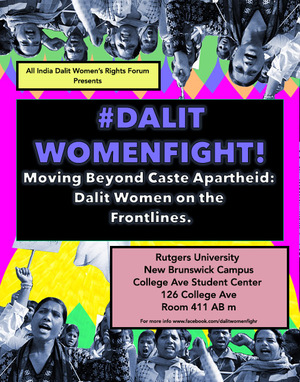
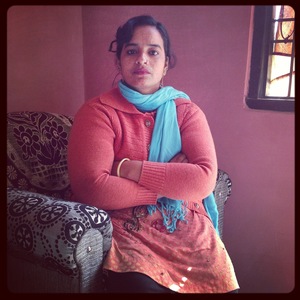
Dev Dass Goswami
Doing God's Work: This Haryana Man Has Been Burying Unclaimed Bodies & Rescuing The Needy For 35 Yrs
Daya Bai
From Wikipedia, the free encyclopedia
Daya Bai
Daya Bai
Born
Mercy Mathew
1940 (age 80–81)
Nationality Indian
Occupation social worker, activist
Known for tribal upliftment
Daya Bai (born Mercy Mathew) is an Indian social activist from Kerala, working among the tribals of central India. She lives in Barul village of Chhindwara district in Madhya Pradesh.
Early life
Mercy Mathew, born in 1940, hails from a prosperous Christian family in Pala, Kerala. She had a happy childhood with a strong faith in God.
Social work
She left Pala at the age of 16 to become a nun, and later gave up her habit, to work for the tribal population in the midlands of India. She has been delivering inspirational speeches, holding satyagrahas and campaigns to press local authorities to open schools and empower neglected villages in the interior and tribal Madhya Pradesh. She was associated with Narmada Bachao Andolan and the Chengara agitation, apart from her solo struggles representing the forest dwellers and villagers in Bihar, Haryana, Madhya Pradesh, Maharashtra and West Bengal. She also lent her services to the common folk in Bangladesh during the war there. Daya Bai, who practises the theology of liberation, settled down among the Gonds of Chhindwara district in Madhya Pradesh. She set up a school in the Barul village. Daya Bai teaches each village she visits how to take care of itself and then moves on to the next village.
She started the Swayam Sahayatha Group in the late 90s, as a tool for the eradication of poverty. This earned her the wrath of the middlemen, the money lenders and village chief. She asked female officers in the bank to use their position for the uplift of the downtrodden and the distressed poor.
Awards
Daya Bai received the Vanitha Woman of the Year award in 2007. She was awarded with the Good Samaritan National Award (instituted by the Kottayam Social Service Society and Agape Movement, Chicago) in January 2012.
Legacy
Ottayal or 'One Person,' is an hour-long documentary on Daya Bai by Shiny Jacob Benjamin. Nandita Das, the film personality, wrote a tribute to her in 2005, as the one inspiration of her life.
Dalit odd Fighers
Chandrashekhar Azad
Born in Ghadkhauli village, Sahranpur, Uttar Pradesh, Chandrashekhar Azad is known to have come to prominence after he put up a board outside his village “The Great Chamars of Ghadkhauli Welcome you”.
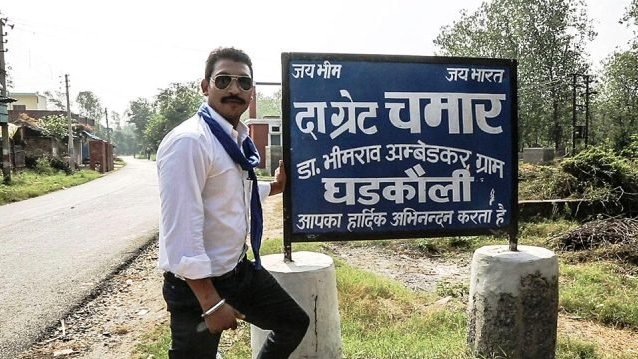
(Image Courtesy: Stars Unfolded)
He is a law graduate and he along with Vinay Ratan Singh co-founded the Bhim Army or the Bhim Army Ekta Mission to fight for the development and upliftment of Dalits and other marginalized sections.
Bhim Army is an unregistered organization and claims to have over 40,000 members across 7 states. It also runs around 300 schools. He was arrested in 2017 for fanning protest by Dalit Community in Saharanpur and was released more than a year later. He was booked under the National Security Act.
He was recently granted bail by a Delhi Court recognising his right to protest as a constitutional right as he was part of anti-CAA protest at Jama Masjid in Delhi. Even when the police were trying to arrest him, he had managed to give them a slip and had emerged in another protest.
Helen Lepcha alias Sabitri Devi
Born in the year 1902, hailing from a village called Sangmoo near Namchi in South Sikkim, but residing in the then British-occupied Kurseong, this fierce freedom fighter was inspired by Gandhi’s Charkha Movement which had gained momentum at that point in time. Helen Lepcha or better known as Sabitri Devi partook in the relief measures that were carried out in Bihar in the year 1920 as the state had confronted massive floods that affected the people from lower echelons of the society. Impressed by her work, Gandhi invited her to his Sabarmati Ashram. She was also renamed as “Sabitri Devi” by Gandhi.
Image Source: Himal News
The Britishers found her dedicated anti-colonial stance and activities as notorious and they had also issued a warrant in her name. She was hounded by the British Police officials and was one of the most-wanted congress leaders. Once she was also open fired at; fortunately, she escaped unhurt. She built a strong rapport with other leaders like Sarojini Naidu, Jawaharlal Nehru, Morarji Desai and worked closely with them for India’s independence.
She also played a significant role in the Non-Cooperation Movement, where she led a rally of thousands of labourers in Kolkata, beside eminent nationalist leaders like Gandhi, Maulana Abdul Kalam Azad, Chittaranjan Das, to name a few. She also mobilised people from in and around Kurseong during the Non-Cooperation Movement by starting door-to-door campaigns against foreign goods, for which she was later imprisoned by the Britishers.
Along with battling the British rule for India’s independence, she also immersed herself in social activism. She was the chairperson of various associations in Kurseong like the Sherpa Association, Nagar Congress, Anjuman Islamia and the Lepcha Association. Because of her dedication to the collective betterment of the society, the Tribal Welfare Department, Government of West Bengal also honoured and recognised her contributions by conferring on her “Reward to Tribal Headman of the District”.
Sabitri Devi
Helen Lepcha alias Sabitri Devi (born 1902) was one of the most prominent freedom fighters from the hills of Darjeeling. Originally a resident of Kurseong, Dist. Darjeeling, she traced her lineage to Sikkim, which honours her as their very own. Around 1917, when a Bengali man has come to propagate Gandhi’s Charkha Movement, Helen, a fresh school-dropout, resonated deeply with his speech. She was so inspired that she took off to Calcutta in 1918, to get enrolled in the Charkha school of the granddaughter of Pt. Ishwar Chandra Vidyasagar. A skilled learner, she soon got the opportunity to be a representative of the school in the National level Khadi and Charkha Exhibition in Muzzafarpur in Bihar.
As history shows, many men from this northern terrain have fought valiantly, especially for the independence of the nation-state they were desperate to belong to. But it never quite acknowledges the bravery of the martial hill women, who tried to make giant gestures not only for the freedom of the country but also for womankind.
When volunteering for the Bihar floods in 1920, Helen was summoned by Gandhi, who had heard about her selfless goodwill towards the unfortunate, to Safidat’s house. Impressed by her dedication to the cause, Gandhi invited her to Sabarmati Ashram, and it was there that Sabitri Devi was born. After her rechristening, she acted as a Congress leader looking after certain parts of Bihar and Uttar Pradesh like Patna, Danapur, Bakipur, Muzzafarpur, and Jharia coalfields and gained immense popularity among the netizens. The British were wary about this, as they staled her every move. With an anti-British stance and a nationalist spirit, she attended almost every event which tried to topple Britannia’s hold on India, and in this process, she is said to have come in close contact with eminent political personalities such as Sarojini Naidu, Jawaharlal Nehru, Moraji Desai and the like.
With the tricolour in hand, Sabitri had led a rally of labourers of Jharia in 1921 as a part of the Non-Cooperation Movement. She carried this spirit back home when having to tend to her mother, as she gathered volunteers to start a campaign against foreign goods in Siliguri. As bonfires were lit with these goods as their fodder, despite the section 144 imposed, the nationalistic fire in their hearts burned brighter leading to rallies, till they were taken into custody. An anti-government case was opened against her, leading to 3-month imprisonment and a further house arrest, till she met with Gandhi in 1925. Rumour has it, she aided Subash Chandra Bose to escape from India. With many titles and awards given to her during her lifetime, Sabitri Devi was revered for the brave woman she was.
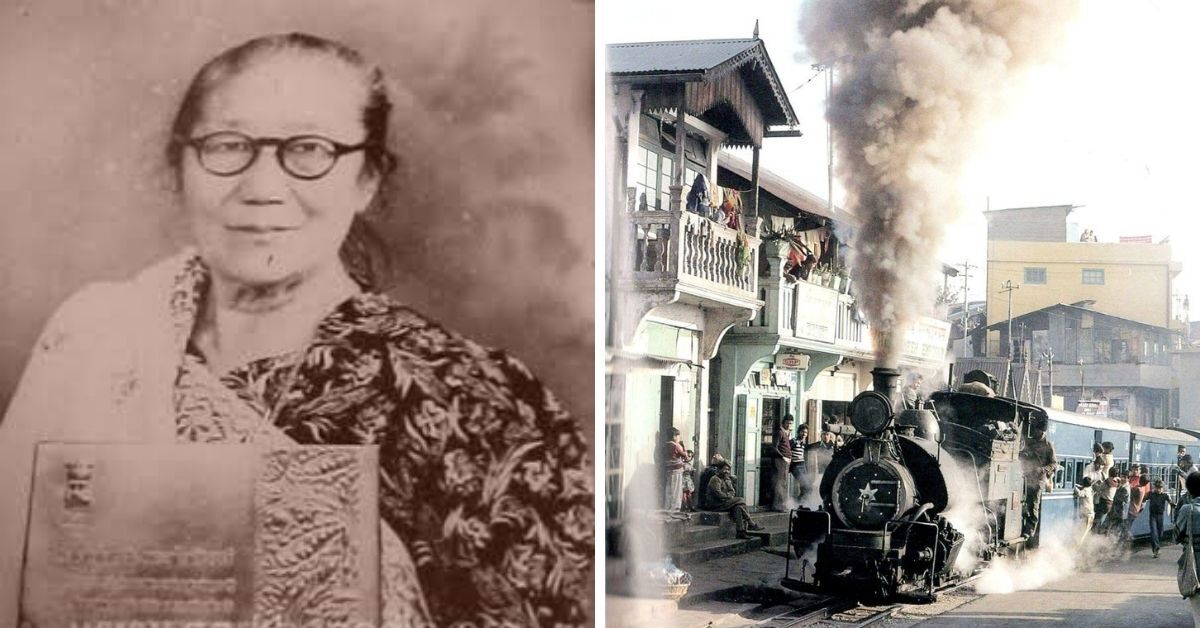
An unsung freedom fighter who helped Netaji Bose escape and fought alongside Mahatma Gandhi in the Non-Cooperation movement, Helen Lepcha (also known as Savitri Devi) remains lost in the pages of India’s history.
A little over a century ago, in the Himalayan town of Kurseong, an hour’s drive from Darjeeling, West Bengal, lived a woman who was an integral part of Mahatma Gandhi’s Non-cooperation Movement. She led a procession of over 10,000 coal mine workers and helped Subash Chandra Bose escape his internment in Kurseong.
Escaping an arrest following a warrant issued against her, she lived at Anand Bhawan (now Swaraj Bhawan) — the residence of Jawaharlal Nehru in Allahabad where she met multiple local Congress leaders. Despite mass popularity, she chose to lead a simple Gandhian life until she breathed her last on 18 August 1980.
Helen Lepcha belonged to the indigenous Lepcha community, an ethnic group scattered across Sikkim, the Darjeeling Hills, the south-western parts of Bhutan and the Ilam District of Nepal.
Born on 14 January 1902, in Sangmu Village (South Sikkim) to Mr and Mrs Achung Lepcha, Helen was the third of seven children. Her family moved to Kurseong shortly after she was born. Surrounded by lush green tea estates with well-pruned bushes, the towns of Kurseong and Darjeeling started witnessing the arrival of education and infrastructural development from the early 19th century. This created ample job opportunities as compared to the then princely state of Sikkim, leading Helen’s father to move to Kurseong.
A fresh school dropout, Helen, joined the Charkha and Khaddar movements that were being propagated in the hills in 1917. A speech delivered by a Bengali gentleman from Calcutta is said to have struck a chord with her. With a conviction to dedicate her life for the cause of her motherland, she left for Calcutta in 1918. Under the tutelage of Ishwar Chandra Vidyasagar’s grand-daughter, Helen learned the art of spinning at her charkha training centre. Owing to her skills, she represented Calcutta at the Khadi and Charkha Exhibition in Muzaffarpur, Bihar.
In 1920, Bihar was torn down by floods affecting hundreds and thousands of people. Helen, selflessly helped the flood-ravaged people and toured the famine struck areas with tenacity. While volunteering, she met Mahatma Gandhi who had come to visit the aggrieved families. Moved by her dedication, a thoroughly impressed Gandhiji invited her to Sabarmati Ashram. At the Mahatma’s invitation, she visited the Ashram where he rechristened her Savitri Devi, as the name ‘Helen’ gave an impression of a foreigner. Helen vigorously participated in the activities of the Congress Labour Union as a leader of the party in parts of Uttar Pradesh (UP) and Bihar.
In 1921, following a meeting at Muhammad Ali Park in Calcutta, she joined Gandhi ji in the Non-cooperation Movement. Subsequently, holding a tri-colour, Helen led a procession of over 10,000 mine workers of the Jharia coal fields (now in Jharkhand) and protested against the exploitation of tribal labours and their replacement. Her soaring popularity perturbed the British. They issued an arrest warrant against her, escaping which she lived in hiding at Nehru’s residence in Allahabad.
In 1921-22, the Non-cooperation Movement reached its pinnacle but the news of her mother’s illness forced Helen to rush to Kurseong. Concurrently, the movement was penetrating into the tea gardens of the Darjeeling hills despite efforts made by the British to keep the hills free from the nationalist movement, as the Gorkha soldiers were their greatest strength. However, this was a result of the British turning a deaf ear to the socio-economic grievances of the tea plantation workers. This stimulated Helen to foster her nationalistic zeal to the Darjeeling hills.
Helen drew together local volunteers and started a door-to-door campaign against foreign goods. Despite a curfew imposed by the police as a result of her campaign, she continued her crusade. This led to her arrest on 29 January 1922. Together with 12 others, Helen was imprisoned at the Darjeeling Sadar Jail for three months, she was later put under house arrest in Kurseong for three years. There she was popularly called Helen didi (sister). In 1932, she was elected the first woman commissioner of Kurseong Municipality.
In 1939-40, when Netaji Subash Chandra Bose was held captive at his house in Kurseong, Helen was in constant touch with him. She would communicate through letters that would be hidden inside the breads sent to Bose from her husband Ishan Ahmed’s bakery. She is said to have helped him escape the house arrest from Kurseong to Calcutta and then to Germany via Kabul. Legends say, the pathan dress, moustache and the beard Netaji used to hide his identity during his escape was made by Helen in Kurseong.
In 1942, Helen actively participated in the Quit India Movement. Besides, she focused on social activism and served as the chairperson of various associations in Kurseong such as the Sherpa association, Nagar Congress, Anjuman Islamia and the Lepcha association. Later in life, she also served as the Mandal of Kurseong.
On 15 August 1972, Helen’s contributions were honoured with the Tamra Patra along with a pension for freedom fighters. It was presented to her by the then Prime Minister Indira Gandhi who fondly remembered Helen from her childhood days at Anand Bhawan and called her Saili didi, referring to the birth order of a person in a family wherein saili is the third born in cases where there are more than three children. She was also made the chairperson of the Freedom Fighter Award Committee of Darjeeling district along with other members.
Stemming from humble roots, Helen’s contributions have been recognised by her birth state Sikkim, where she has been conferred with the title ‘Daughter of the soil’. Her struggles, however, remain lost from the pages of history.
(Written by Kritika Sarda)
K S Badalia
:
B.Com, LLB (Delhi University.)
Born on 15-02-1953 at Vill. Karola-District- Gurgaon (Haryana); General Manager Prathama Bank, AGM-Syndicate Bank, Great Fighter & Most popular SC&ST Employees Leader, Won a historical Supreme Court Judgment dated 10-08-1990 wherein reservation in promotions up to Highest level was upheld. Got recognition to SC&ST Employees Associations, Got properly & aggressively implemented reservations in direct recruitments and promotions in Banks & 0ther Departments/PSUs.
Matthew Henson
From Wikipedia, the free encyclopedia
Matthew Henson
Born
Matthew Alexander Henson
August 8, 1866
Nanjemoy, Maryland, U.S.
Died March 9, 1955 (aged 88)
The Bronx, New York, US
Resting place Arlington National Cemetery
Known for Arctic explorer, claimed as the first to reach the geographic North Pole
Spouse(s)
Eva Flint
(m. 1891–1897)
(m. 1907)
Akatingwah (concubine)
Children Anauakaq (1906–1987; by Akatingwah)
Matthew Alexander Henson (August 8, 1866 – March 9, 1955) was an American explorer who accompanied Robert Peary on seven voyages to the Arctic over a period of nearly 23 years. They spent a total of 18 years on expeditions together. He is best known for his participation in the 1908–1909 expedition that claimed to have reached the geographic North Pole on April 6, 1909. Henson said he was the first of their party to reach the pole.
Henson was born in Nanjemoy, Maryland, to sharecropper parents who were free Black Americans before the Civil War. He spent most of his early life in Washington, D.C., but left school at the age of twelve to work as a cabin boy. He later returned to Washington and worked as a salesclerk at a good department store. One of his customers was Robert Peary, who in 1887 hired him as a personal valet. At the time, Peary was working on the Nicaragua Canal.
Their first Arctic expedition together was in 1891–92. Henson served as a navigator and craftsman, and was known as Peary's "first man". Like Peary, he studied Inuit survival techniques.
During their 1908–09 expedition to Greenland, Henson was one of the six men – including Peary and four Inuit assistants – who claimed to have been the first to reach the geographic North Pole. In interviews, Henson identified as the first member of the party to reach what they believed was the pole. Their claim had gained widespread acceptance but in 1989, Wally Herbert published research that found that their expedition records were unreliable and indicated an implausibly high speed during their final rush for the pole, and that the men could have fallen 30–60 miles (48–97 km) short of the pole due to navigational errors.
Henson achieved a degree of fame as a result of participating in the expedition, and in 1912 he published a memoir titled A Negro Explorer at the North Pole. As he approached old age, his exploits received renewed attention. In 1937 he was the first African American to be made a life member of The Explorers Club; in 1948 he was elevated to the club's highest level of membership. In 1944 Henson was awarded the Peary Polar Expedition Medal, and he was received at the White House by Presidents Harry Truman and Dwight Eisenhower. In 1988 he and his wife were re-interred at Arlington National Cemetery. In 2000 Henson was posthumously awarded the Hubbard Medal by the National Geographic Society.
Early life and education
Henson was born on August 8, 1866 on his parents' farm east of the Potomac River in Charles County, Maryland, to sharecroppers who had been free people of color before the American Civil War. Matthew's parents were subjected to attacks by the Ku Klux Klan and other white supremacist groups, who terrorized southern freedmen and former free people of color after the Civil War.
To escape from racial violence in southern Maryland, in 1867 the Henson family sold the farm and moved to Georgetown, then still an independent town adjacent to the national capital.He had an older sister S., born in 1864, and two younger sisters Eliza and M.Matthew's mother died when Matthew was seven. His father Lemuel remarried to a woman named Caroline and had additional children with her, including daughters and a son.
After his father died, Matthew was sent to live with his uncle, who lived in Washington, D.C. (Georgetown was made part of Washington, DC in 1871.) The uncle paid for a few years of education for Matthew but soon died. Henson attended a black public school for the next six years, during the last of which he took a summer job washing dishes in a restaurant. His early years were marked by one especially memorable event. When he was 10 years old, he went to a ceremony honoring Abraham Lincoln, the American president who had fought so hard to preserve the Union during the Civil War and had issued the proclamation that had freed slaves in the occupied Confederate states in 1863. At the ceremony, Matthew was greatly inspired by a speech given by Frederick Douglass, an escaped slave and renowned orator, the longtime leading figure in the American black community. Douglass called upon blacks to vigorously pursue educational opportunities and battle racial prejudice.
At the age of twelve, the youth made his way to Baltimore, Maryland, a busy port. He went to sea as a cabin boy on the merchant ship Katie Hines, traveling to ports in China, Japan, Africa, and the Russian Arctic seas.[5][better source needed] The ship's leader, Captain Childs, took Henson under his wing and taught him to read and write.
Exploration
Henson in his Arctic furs
While working at a Washington D.C. clothing store, B.H. Stinemetz and Sons, in November 1887, Henson met Commander Robert E. Peary. Learning of Henson's sea experience, Peary recruited him as an aide for his planned voyage and surveying expedition to Nicaragua, with four other men. Peary supervised 45 engineers on the canal survey in Nicaragua. Impressed with Henson's seamanship on that voyage, Peary recruited him as a colleague and he became "first man" in his expeditions.
After that, for more than 20 years, their expeditions were to the Arctic. Henson traded with the Inuit and mastered their language[clarification needed]; they called him Mahri-Pahluk. He was remembered as the only non-Inuit who became skilled in driving the dog sleds and in training dog teams in the Inuit way. He was a skilled craftsman, often coming up with solutions for what the team needed in the harsh Arctic conditions; they learned to build igloos out of snow, for mobile housing as they traveled. His and Peary's teams covered thousands of miles in dog sleds and reached the "Farthest North" point of any Arctic expedition until 1909.
1908–09 expedition
Photograph of Henson and the four Inuit guides on the last stretch of their 1908–09 expedition, taken by Peary at what they believed to be the North Pole.
In 1908–09, Peary mounted his eighth attempt to reach the North Pole. The expedition was large, as Peary planned to use his system of setting up cached supplies along the way. When he and Henson boarded his ship Roosevelt, leaving Greenland on August 18, 1909, they were accompanied by
22 Inuit men, 17 Inuit women, 10 children, 246 dogs, 70 tons (64 metric tons) of whale meat from Labrador, the meat and blubber of 50 walruses, hunting equipment, and tons of coal. In February, Henson and Peary departed their anchored ship at Ellesmere Island's Cape Sheridan, with the Inuit men and 130 dogs working to lay a trail and supplies along the route to the Pole.
Peary selected Henson and four Inuit as part of the team of six men who would make the final run to the Pole. Before the goal was reached, Peary could no longer continue on foot and rode in a dog sled. Various accounts say he was ill, was exhausted, or had frozen toes. He sent Henson ahead as a scout.
In a newspaper interview, Henson later said:
I was in the lead that had overshot the mark a couple of miles. We went back then and I could see that my footprints were the first at the spot.
Henson proceeded to plant the American flag.
The claim by Peary's team to have reached the North Pole was widely debated in newspapers at the time, as was the competing claim by Frederick Cook. The National Geographic Society, as well as, the Naval Affairs Subcommittee of the U.S. House of Representatives both credited Peary's team with having reached the North Pole. Others remained doubtful. A reassessment of Peary's notebook by British polar explorer Wally Herbert in 1988 found it "lacking in essential data", thus, renewing doubts about Peary's claim.
Later life
Photograph of Henson in civilian clothing, taken from his 1912 book A Negro Explorer at the North Pole.
In 1912 Henson published a memoir about his arctic explorations, A Negro Explorer at the North Pole. In this, he describes himself as a "general assistant, skilled craftsperson, interpreter [he had learned an Inuit language], and laborer." He later collaborated with author Bradley Robinson on his 1947 biography, Dark Companion, which told more about his life.
During the following decades, Admiral Peary received many honors for leading the expedition to the Pole, but Henson's contributions were largely ignored. In 1909 he was honored at dinners within the black community. Henson spent most of the next 30 years working on staff in the U.S. Customs House in New York, at the suggestion of Theodore Roosevelt.
He later gained renewed attention. In 1937 Henson was admitted as a member to the prestigious Explorers Club in New York City, and in 1948 he was made an honorary member, of whom there are only 20 per year. In 1944 Congress awarded him and five other Peary aides duplicates of the Peary Polar Expedition Medal, a silver medal given to Peary. Presidents Truman and Eisenhower both honored Henson before he died in 1955.
Henson died in the Bronx on March 9, 1955, at the age of 88. He was buried at Woodlawn Cemetery and survived by his wife Lucy. After her death in 1968, she was buried with him. In 1988, both their bodies were moved for reinterment at Arlington National Cemetery, accompanied by a commemoration ceremony.
Family
Henson married Eva Flint in 1891, but their marriage did not survive their long periods of separation and they divorced in 1897. He later married Lucy Ross in New York City on September 7, 1907. They had no children.
During the extended expeditions to Greenland, Henson and Peary both took Inuit women as "country wives" and fathered children with them. With his concubine, known as Akatingwah, Henson fathered his only child, a son named Anauakaq, born in 1906. Anauakaq's children are Henson's only descendants. After 1909, Henson never saw Akatingwah or his son again; other explorers sometimes updated him about them. The existence of Henson's and Peary's descendants was first made public by French explorer and ethnologist Jean Malaurie who spent a year in Greenland in 1951–52.
S. Allen Counter, a neuroscientist and director of the Harvard Foundation, had long been interested in Henson's story and traveled in Greenland for research related to it. Learning of possible descendants of the explorers, in 1986 he tracked down Henson's and Peary's sons, Anauakaq and Kali, respectively. By then the men were octogenarians. He arranged a visit for them the following year to the United States, where they met American relatives from both families and visited their fathers' graves.Anauakaq died in 1987. He and his wife Aviaq had five sons and a daughter, who have children of their own. While some still reside in Greenland, others have moved to Sweden or the United States.
Several Inuit family members returned to Washington, D.C., in 1988 for the ceremony of reinterment of Henson and his wife Lucy at Arlington National Cemetery. Counter had petitioned President Ronald Reagan for this honor to gain recognition of Henson's contributions to Arctic exploration. Counter wrote a book about his finding Anauakaq and Kali, his research on Henson's life and contributions, historical racial relations, and the Inuits' meeting with Henson and Peary relatives in the United States, entitled North Pole Legacy: Black, White and Eskimo (1991). The material was also adapted and produced as a film documentary by the same name.
Extended family
Matthew Henson's only direct descendants were the children of his Inuit son and their children. According to S. Allen Counter, in his lifetime Henson had identified families of two nieces as being part of his extended birth family. They were Virginia Carter Brannum, daughter of Henson's sister Eliza Henson Carter of Washington, D.C., and Olive Henson Fulton of Boston, daughter of his half-brother. In a 1988 article, Counter noted that these two women had letters and photographs certifying their kinship. They were the only family members to attend Henson's funeral in 1955, along with his widow Lucy Ross Henson. Counter later recommended to the United States Navy and the National Geographic Society that Audrey Mebane, daughter of Virginia Brannum, and Olive Henson Fulton be designated as family representatives for any ceremonies honoring Henson.
Henson is believed to be a brother of the great-great-grandfather of actress Taraji P. Henson.
Legacy and honors
Henson's grave in Arlington National Cemetery in Arlington, Virginia, U.S.
Entrance of the site of the former Matthew Henson Public Housing Project.
On October 19, 1909, Henson was the guest of honor at a dinner ceremony held by the Colored Citizens of New York, where he was honored by toasts and given a gold watch and chain.
In 1937, The Explorers Club, under its "polar" President Vilhjalmur Stefansson, invited Henson to join its ranks.
In 1940, a public housing project, for affordable housing for Phoenix African Americans, was named after Matthew Henson. The former site of the project was recognized as part of a historic district by the Phoenix Historic Property Register in June 2005. Only one courtyard with the original buildings remains.
In 1940, Henson was honored with one of the 33 dioramas at the American Negro Exposition in Chicago.
In 1945, Henson and other Peary aides were given U.S. Navy medals for their Arctic achievements.
In 1948, the Club awarded the explorer its highest rank of Honorary Member, an honor reserved for no more than 20 living members at a time.
In 1954, Henson was invited to the White House
Before his death in 1955, Henson received honorary doctoral degrees from Howard University and Morgan State University.
On May 28, 1986, the United States Postal Service issued a 22 cent postage stamp in honor of Henson and Peary; they were previously honored in 1959, but not by name.
In 1988 Henson and his wife Lucy were reinterred in Arlington National Cemetery, with a monument to his exploring achievements, near Peary's grave and monument. Many members from his Inuit descendants (Anauakaq's children) and extended American family attended.
In October 1996, the United States Navy commissioned USNS Henson, a Pathfinder class Oceanographic Survey Ship, named in honor of Matthew Henson.
In 2000, the National Geographic Society awarded the Hubbard Medal to Matthew A. Henson posthumously. The medal was presented to Henson's great-niece Audrey Mebane at the newly named Matthew A. Henson Earth Conservation Center in Washington, D.C.; in addition, the NGS established a scholarship in Henson's name.
Places in Maryland named in Henson's honor include the following: Matthew Henson State Park in Aspen Hill, Matthew Henson Middle School in Pomonkey, and elementary schools named for him in Baltimore and Palmer Park.
The Henson Glacier (Greenland) was named after him.
In October 2020, the previously named Columbus GPS Block III satellite was renamed after the launch as Matthew Henson.
Representation in media
"Matthew Henson, Black Explorer" is part of the series "The Scooby-Doo Gang: Black Explorers" released in 1978 by Hanna-Barbera Educational Filmstrips. Catalog number 52410.
S. Allen Counter's book, North Pole Legacy: Black, White and Eskimo (1991), discusses the explorations, as well as Peary and Henson's "country wives" (Inuit women) and their part-Inuit descendants, and historical race relations. He made a film documentary by the same name, shown on the Monitor Channel in 1992.
The 1998 TV movie Glory & Honor was about the Peary-Henson explorations and their lives. Henson was played by Delroy Lindo, and Henry Czerny played Robert Peary. The film won a Primetime Emmy and Lindo won a Golden Satellite Award for his performance.
Henson's role in polar expeditions was included in E.L. Doctorow's novel, Ragtime (1975).[
Donna Jo Napoli's young adult novel, North, is set against Henson's life and role in polar expeditions.
In 2012, the German artist Simon Schwartz published a graphic novel about Henson, entitled Packeis (pack ice), which won the Max & Moritz Prize for the "Best German-language Comic Book." The novel was published in English as First Man: Reimagining Matthew Henson in 2015.
In the graphic novel Sous le soleil de minuit, published in 2015 by writer Juan Díaz Canales and artist Rubén Pellejero, Henson helps Corto Maltese in his Alaskan adventure in 1915.
Henson's story is featured in Kevin Hart's Guide to Black History on Netflix.
ओपरा विनफ़्रे जीवनी
Oprah Winfrey
Published By : Jivani.org
ओपरा विनफ़्रे (अंग्रेज़ी: Oprah Winfrey) (जन्म ओर्पाह गैल विनफ्रे (अंग्रेज़ी: Orpah Gail Winfrey, २९ जनवरी १९५४) एक अमरीकी मिडिया उद्योजक, वार्ता शो मेज़बान, अभिनेत्री, निर्माता व लिपिकार है। विनफ़्रे को उनके स्वयं के नाम के कई पुरस्कार विजेता शो के कारण जाना जाता है जो १९८६ से २०११ तक प्रसारित किया गया व इतिहास का सबसे अधिक रेटिंग वाला धारावाहिक बन गया। उन्हें २०वि सदी की अमेरिका की सबसे रइस अफ़्रीकी अमरीकी लिपिकार होने का सम्मान प्राप्त है और एक काल में वे विश्व की अकेली अश्वेत अरबपति थी। कुछ जानकारों के अनुसार वे विश्व की सबसे प्रभावकारी महिलाओं में से एक है।
विनफ़्रे का जन्म मिसिसिप्पी के एक गरीब गाँव में कुवांरी माँ के यहाँ हुआ था व उनका बचपन मिल्वौकी में हुआ। अपने बचपन में उन्होंने उन्हें कई मुसीबतों का सामना करना पड़ा जिनमे उनके अनुसार नौ वर्ष की आयु में उनका बलात्कार किया गया था व चौदाह की उम्र में वे गर्भवती हो गई थीळ उनका बेटा गर्भ में ही मर गया था। टेंनेसी में एक हज्जाम के यहाँ उन्हें रहने के लिए छोड दिया गया जिन्हें वे अपना पिता कहती है। वहां रहते हुए उन्होंने एक रेडियो में कार्य करना प्रारंभ किया और साथ ही साथ १९ की उम्र में हाई स्कुल में पढ़ाई करते हुए घरेलु समाचार में सह-मेज़बान भी बन गई। उनकी भावनाओं से प्रेरित वक्तव्यों के चलते उन्हें दिन में प्रसारित होने वाले वार्ता शो का अधिकार प्रदान किया और इस शो को शिकागो के प्रथम क्रमांक का शो बनाने के बाद उन्होंने अपनी स्वयं की निर्माण कंपनी खोल दी व विश्वभर में प्रसारण करना शुरू कर दिया।
प्रारंभिक जीवन
विनफ्रे का नाम “ओपरा” बाइबिल से सम्बंधित है. ये नाम उनके जन्म प्रमाणपत्र पर तो नही है लेकिन फिर भी लोग उन्हें बाइबिल के ही एक नाम ओपरा के नाम से पुकारते थे, और बाद में यही ओपरा उनके नाम के आगे लगाया गया.
विनफ्रे का जन्म मिसिसिप्पी के एक गरीब गाँव में कुंवारी माँ के यहाँ हुआ था. उनकी माता वेर्निटा ली (जन्म 1935) एक गृहिणी है. विनफ्रे के जैविक पिता वेर्नों विनफ्रे (जन्म 1933) को माना जाता है, जो एक कोयला खोदने वाले थे बाद में विनफ्रे के जन्म के समय सशस्त्र सेना के साथ थे. जबकि, मिसिसिप्पी के किसानो और द्वितीय विश्वयुद्ध के वेटेरन नोआह रोबिनसन (जन्म C.1925) ने ही उनके जैविक पिता को खोजा था. 2006 में की गयी अनुवांशिक परीक्षा गयी ताकि उनका राष्ट्रीयत्व पता किया जा सके. जिसमे पाया गया की विनफ्रे 89 % सब-सहारन अफ्रीकन, 8% रहवासी अमेरिकन और 3% ईस्ट अमेरिकन है.
विनफ्रे के जन्म के बाद उनकी माँ ने उत्तर की यात्रा की और 6 वर्ष की आयु में, विनफ्रे अपनी माता वेर्निटा ली के साथ मिल्वौकी के पडोसी गाव विस्कॉन्सिन रहने के लिए गयी. जहा उन्हें किसी के सहायता की जरुरत थी, यहाँ पर उनकी सहायता के लिए उनकी नानी भी नही थी, इसीलिए उन्हें घंटो तक काम करना पड़ता था. वे एक नौकर की तरह काम करने लगी थी. इसी समय ली ने एक और बेटी को जन्म दिया, जो विनफ्रे की छोटी बहन थी, जिसका नाम बाद में पेट्रीचिया (Patricia) रखा गया.
13 वर्ष की आयु में, अपना शोषण होने के बाद विनफ्रे घर से भाग गयी. जब वह 14 साल की थी तभी वह भी गर्भवती हुई लेकिन उनका बेटा गर्भ में ही बीमारी की वजह से मारा गया था.
पिता का साथ
पिता की छत्र-छाया में ओपरा की जिंदगी ने नई सुबह का आगाज़ किया। ये लाइफ का ऐसा टर्निंग प्वाइंट था, जिससे जिंदगी को नया आयाम मिला। पिता ने अपनी सुरक्षा में अनुशासन में रहना सिखा दिया। ओपरा की शिक्षा पिता वर्नन की प्राथमिकता थी, ओपरा ने भी अपने जीवन में आये इस सकारात्मक बदलाव को स्वीकार किया। पूरी लगन से पढ़ाई करने लगी और बहुत जल्द ही सभी टिचर्स की पहली पसंद बन गई। पिता की सीख और सुरक्षा में ओपरा अपना अतीत भूलकर आगे बढ़ने लगी।
उनका कहना था कि,
वो पिता वर्नन विनफ्रे ही थे जिन्होंने अभाव में भी जीवन को सही आकार और आत्मविश्वास दिया।
स्कूल में हो रही सभी गतिविधियों में वो भाग लेने लगीं। नाटक हो या डिबेट सब में अव्वल रहने लगीं। एक भाषण प्रतियोगिता में ओपरा ने टैनेसी स्टेट यूनिवर्सिटी के लिए स्कालरशिप जीती। उसके अगले साल ओपरा को यूथ कांफ्रेंस में व्हाईट हाउस जाने का अवसर मिला। जिंदगी में सम्मान की बारिश होने लगी। उन्होंने नैशविल के स्थानीय रेडियो स्टेशन से “मिस फायर प्रिवेंशन” प्रतियोगिता जीती जिससे उनको दोपहर का समाचार पढ़ने का मौका मिला।
अपनी आवाज और बोलने की अद्भुत शैली के कारण वे आसमान की बुलंदियों पर उड़ने लगी। एक के बाद एक उपलब्धियों से उनका व्यक्तित्व और निखरने लगा। पिता द्वारा रोपित आत्मविश्वास का पौधा एक पेड़ में परिवर्तित हो गया था।
टेलीविजन
स्थानीय मीडिया में काम करना, वह नैशविले के डब्लूएलएसी-टीवी में सबसे कम उम्र के समाचार एंकर और पहली काली महिला समाचार एंकर थीं। वह 1 9 76 में बाल्टिमोर के डब्लूजेज़-टीवी में चले गए और छह बजे खबर के सह-एंकर थे। 1 9 77 में, उन्हें सह-एंकर के रूप में हटा दिया गया था और स्टेशन पर निम्न प्रोफ़ाइल पदों पर काम किया था। उसके बाद वह 14 जून 1 9 78 को प्रीमियर हुआ डब्लूजेड के स्थानीय टॉक शो पीपेल हो टॉकिंग के सह-मेजबान के रूप में रिचर्ड शेर को शामिल करने के लिए भर्ती कराया गया। उन्होंने वहां डायलिंग फॉर डलरर्स के स्थानीय संस्करण की मेजबानी की।
1 9 83 में, डब्ल्यूएलएस-टीवी के कम-रेटेड आधे घंटे की सुबह के टॉक शो, एएम शिकागो की मेजबानी करने के लिए, विनफ्रे शिकागो में जगह ले गई। पहला एपिसोड 2 जनवरी 1 9 84 को प्रसारित हुआ। विन्फ्रे ने पद संभालने के कुछ महीनों बाद, यह शो रेटिंग में आखिरी स्थान पर चला गया और डोनह्यू को शिकागो में उच्चतम दर्जा वाले टॉक शो के रूप में आगे बढ़ा। फिल्म समीक्षक रोजर एबर्ट ने उन्हें राजा विश्व के साथ एक सिंडिकेशन सौदे पर हस्ताक्षर करने के लिए प्रेरित किया एबर्ट ने भविष्यवाणी की थी कि वह अपने टेलीविज़न शो, एट द मूवीज के रूप में 40 गुना अधिक राजस्व उत्पन्न करेगी। इसका नाम बदलकर ओपरा विन्फ्रे शो का विस्तार, एक पूर्ण घंटे तक बढ़ाया गया और राष्ट्रीय स्तर पर 8 सितंबर 1 9 86 को प्रसारित किया गया। विन्फ्रे के सिंडिकेटेड शो ने डबल डोनाह्यू के राष्ट्रीय श्रोताओं में लाया, जो अमेरिका में संख्या-एक दिन के टॉक शो के रूप में डोनह्यू को स्थानांतरित कर रहा था। उनके बहुत प्रचारित प्रतियोगिता में भारी जांच का विषय था।
Oprah Winfrey (English)
From Wikipedia, the free encyclopedia
"Oprah" redirects here. For the talk show, see The Oprah Winfrey Show.
Oprah Winfrey
Winfrey in October 2014
Born
Orpah Gail Winfrey January 29, 1954 (age 65)
Kosciusko, Mississippi, U.S.
Residence
Montecito, California
Lavallette, New Jersey
Telluride, Colorado
Chicago, Illinois
Fisher Island, Florida
Alma mater Tennessee State University
Occupation
Host of The Oprah Winfrey Show (1986–2011)
Chairwoman and CEO of Harpo Productions (1986–present)
Chairwoman, CEO and CCO of the Oprah Winfrey Network (2011–present)
Actress
Author
Years active 1971–present
Salary $75 million (2013)
Net worth  US$2.6 billion (January 2019)
US$2.6 billion (January 2019)
 US$2.6 billion (January 2019)
US$2.6 billion (January 2019)Political party Independent
Partner(s) Stedman Graham (1986–present)
Children Canaan (born c. 1968, died c. 1968)
Website oprah.com
Signature
Oprah Gail Winfrey (born Orpah, January 29, 1954) is an American media executive, actress, talk show host, television producer and philanthropist. She is best known for her talk show The Oprah Winfrey Show, which was the highest-rated television program of its kind in history and was nationally syndicated from 1986 to 2011 in Chicago.Dubbed the "Queen of All Media" she was the richest African American of the 20th century and North America's first black multi-billionaire, and has been ranked the greatest black philanthropist in American history. She has also been sometimes ranked as the most influential woman in the world.
Winfrey was born into poverty in rural Mississippi to a teenage single mother and later raised in inner-city Milwaukee. She has stated that she was molested during her childhood and early teens and became pregnant at 14; her son was born prematurely and died in infancy. Winfrey was then sent to live with the man she calls her father, Vernon Winfrey, a barber in Tennessee, and landed a job in radio while still in high school. By 19, she was a co-anchor for the local evening news. Winfrey's often emotional, extemporaneous delivery eventually led to her transfer to the daytime talk show arena, and after boosting a third-rated local Chicago talk show to first place, she launched her own production company and became internationally syndicated.
Credited with creating a more intimate confessional form of media communication,Winfrey popularized and revolutionized the tabloid talk show genre pioneered by Phil Donahue. Through this medium, Winfrey broke 20th-century taboos and allowed LGBT people to enter the mainstream through television appearances. In 1994, she was inducted into the National Women's Hall of Fame.
By the mid-1990s, Winfrey had reinvented her show with a focus on literature, self-improvement, mindfulness and spirituality. Though she was criticized for unleashing a confession culture, promoting controversial self-help ideas, and having an emotion-centered approach, she has also been praised for overcoming adversity to become a benefactor to others. Winfrey had also emerged as a political force in the 2008 presidential race, delivering about one million votes to Barack Obama in the razor close 2008 Democratic primary. In 2013, Winfrey was awarded the Presidential Medal of Freedom by President Obama and honorary doctorate degrees from Duke and Harvard. In 2008, she formed her own network, Oprah Winfrey Network (OWN).
Early lifeBorn Orpah Gail Winfrey, her first name was spelled Orpah (not Oprah) on her birth certificate after the biblical figure of that name in the Book of Ruth, but people mispronounced it regularly and "Oprah" stuck.She was born in Kosciusko, Mississippi, to an unmarried teenage mother. She later said that her conception was due to a single sexual encounter and the couple broke up not long after. Her mother, Vernita Lee (1935–2018), was a housemaid. Winfrey's biological father is usually noted as Vernon Winfrey (born c. 1933), a coal miner turned barber turned city councilman who had been in the Armed Forces when she was born. However, Mississippi farmer and World War II veteran Noah Robinson Sr. (born c. 1925) has claimed to be her biological father.
A genetic test in 2006 determined that her matrilineal line originated among the Kpelle ethnic group, in the area that today is Liberia. Her genetic makeup was determined to be 89% Sub-Saharan African, 8% Native American, and 3% East Asian. However, the East Asian markers may, given the imprecision of genetic testing, actually be Native American.
After Winfrey's birth, her mother traveled north, and Winfrey spent her first six years living in rural poverty with her maternal grandmother, Hattie Mae (Presley) Lee (April 15, 1900 – February 27, 1963), who was so poor that Winfrey often wore dresses made of potato sacks, for which the local children made fun of her. Her grandmother taught her to read before the age of three and took her to the local church, where she was nicknamed "The Preacher" for her ability to recite Bible verses. When Winfrey was a child, her grandmother would hit her with a stick when she did not do chores or if she misbehaved in any way.
At age six, Winfrey moved to an inner-city neighborhood in Milwaukee, Wisconsin, with her mother, who was less supportive and encouraging than her grandmother had been, largely as a result of the long hours she worked as a maid. Around this time, Lee had given birth to another daughter, Winfrey's younger half-sister, Patricia who later (in February 2003, at age 43) died of causes related to cocaine addiction.
By 1962, Lee was having difficulty raising both daughters so Winfrey was temporarily sent to live with Vernon in Nashville, Tennessee. While Winfrey was in Nashville, Lee gave birth to a third daughter who was put up for adoption (in the hope of easing the financial straits that had led to Lee's being on welfare) and was later also named Patricia.Winfrey did not learn she had a second half-sister until 2010. By the time Winfrey moved back with her mother, Lee had also given birth to a boy named Jeffrey, Winfrey's half-brother, who died of AIDS-related causes in 1989.
Winfrey has stated she was molested by her cousin, uncle, and a family friend, starting when she was nine years old, something she first announced to her viewers on a 1986 episode of her TV show regarding sexual abuse. When Winfrey discussed the alleged abuse with family members at age 24, they reportedly refused to believe her account.
Winfrey once commented that she had chosen not to be a mother because she had not been mothered well. At 13, after suffering what she described as years of abuse, Winfrey ran away from home. When she was 14, she became pregnant but her son was born prematurely and he died shortly after birth. Winfrey later stated she felt betrayed by the family member who had sold the story of her son to the National Enquirer in 1990.
She began attending Lincoln High School in Milwaukee, but after early success in the Upward Bound program, was transferred to the affluent suburban Nicolet High School, where she says her poverty was constantly rubbed in her face as she rode the bus to school with fellow African-Americans, some of whom were servantsof her classmates' families. She began to steal money from her mother in an effort to keep up with her free-spending peers, to lie to and argue with her mother, and to go out with older boys.
Her frustrated mother once again sent her to live with Vernon in Nashville, although this time she did not take her back. Vernon was strict but encouraging, and made her education a priority. Winfrey became an honors student, was voted Most Popular Girl, and joined her high school speech team at East Nashville High School, placing second in the nation in dramatic interpretation.
She won an oratory contest, which secured her a full scholarship to Tennessee State University, a historically black institution, where she studied communication. Her first job as a teenager was working at a local grocery store.At the age of 17, Winfrey won the Miss Black Tennessee beauty pageant. She also attracted the attention of the local black radio station, WVOL, which hired her to do the news part-time.She worked there during her senior year of high school, and again while in her first two years of college.
Winfrey's career choice in media would not have surprised her grandmother, who once said that ever since Winfrey could talk, she was on stage. As a child, she played games interviewing her corncob doll and the crows on the fence of her family's property. Winfrey later acknowledged her grandmother's influence, saying it was Hattie Mae who had encouraged her to speak in public and "gave me a positive sense of myself".
Television
Working in local media, she was both the youngest news anchor and the first black female news anchor at Nashville's WLAC-TV. She moved to Baltimore's WJZ-TV in 1976 to co-anchor the six o'clock news. In 1977, she was removed as co-anchor and worked in lower profile positions at the station. She was then recruited to join Richard Sher as co-host of WJZ's local talk show People Are Talking, which premiered on August 14, 1978. She also hosted the local version of Dialing for Dollars.
In 1983, Winfrey relocated to Chicago to host WLS-TV's low-rated half-hour morning talk show, AM Chicago. The first episode aired on January 2, 1984. Within months after Winfrey took over, the show went from last place in the ratings to overtaking Donahue as the highest-rated talk show in Chicago. The movie critic Roger Ebert persuaded her to sign a syndication deal with King World. Ebert predicted that she would generate 40 times as much revenue as his television show, At the Movies. It was renamed The Oprah Winfrey Show, expanded to a full hour and broadcast nationally beginning September 8, 1986.Winfrey's syndicated show brought in double Donahue's national audience, displacing Donahue as the number-one daytime talk show in America. Their much-publicized contest was the subject of enormous scrutiny. TIME magazine wrote:
“ Few people would have bet on Oprah Winfrey's swift rise to host of the most popular talk show on TV. In a field dominated by white males, she is a black female of ample bulk. As interviewers go, she is no match for, say, Phil Donahue ... What she lacks in journalistic toughness, she makes up for in plainspoken curiosity, robust humor and, above all empathy. Guests with sad stories to tell are apt to rouse a tear in Oprah's eye ... They, in turn, often find themselves revealing things they would not imagine telling anyone, much less a national TV audience. It is the talk show as a group therapy session. ”
TV columnist Howard Rosenberg said, "She's a roundhouse, a full course meal, big, brassy, loud, aggressive, hyper, laughable, lovable, soulful, tender, low-down, earthy, and hungry. And she may know the way to Phil Donahue's jugular." Newsday's Les Payne observed, "Oprah Winfrey is sharper than Donahue, wittier, more genuine, and far better attuned to her audience, if not the world" and Martha Bayles of The Wall Street Journal wrote, "It's a relief to see a gab-monger with a fond but realistic assessment of her own cultural and religious roots."
In the early years of The Oprah Winfrey Show, the program was classified as a tabloid talk show. In the mid-1990s, Winfrey adopted a less tabloid-oriented format, hosting shows on broader topics such as heart disease, geopolitics, spirituality, and meditation, interviewing celebrities on social issues they were directly involved with, such as cancer, charity work, or substance abuse, and hosting televised giveaways including shows where every audience member received a new car (donated by General Motors) or a trip to Australia (donated by Australian tourism bodies).
In addition to her talk show, Winfrey also produced and co-starred in the 1989 drama miniseries The Women of Brewster Place and a short-lived spin-off, Brewster Place. As well as hosting and appearing on television shows, Winfrey co-founded the women's cable television network Oxygen which was the initial network for her Oprah After the Show program from 2002 to 2006 before moving to Oprah.com when Winfrey sold her stake in the network. She is also the president of Harpo Productions (Oprah spelled backwards). She also moderated three ABC Afterschool Specials from 1992 to 1994.
On January 15, 2008, Winfrey and Discovery Communications announced plans to change Discovery Health Channel into a new channel called OWN: Oprah Winfrey Network. It was scheduled to launch in 2009 but was delayed, and actually launched on January 1, 2011.
The series finale of The Oprah Winfrey Show aired on May 25, 2011.
In January 2017, CBS announced that Winfrey would join 60 Minutes as a special contributor on the Sunday evening news magazine program starting in September 2017. The National Museum of African American History and Culture in 2018 opened a special exhibit on Winfrey's cultural influence through television.Winfrey left 60 Minutes by the end of 2018.
In June 2018, Apple announced a multi-year content partnership with Winfrey, in which it was agreed that Winfrey would create new original programs exclusively for Apple's streaming service, Apple TV+.
Celebrity interviewsIn 1993, Winfrey hosted a rare prime-time interview with Michael Jackson, which became the fourth most-watched event in American television history as well as the most watched interview ever, with an audience of 36.5 million. On December 1, 2005, Winfrey appeared on the Late Show with David Letterman to promote the new Broadway musical The Color Purple, of which she was a producer, joining the host for the first time in 16 years. The episode was hailed by some as the "television event of the decade" and helped Letterman attract his largest audience in more than 11 years: 13.45 million viewers. Although a much-rumored feud was said to have been the cause of the rift, both Winfrey and Letterman balked at such talk. "I want you to know, it's really over, whatever you thought was happening", said Winfrey. On September 10, 2007, Letterman made his first appearance on The Oprah Winfrey Show, as its season premiere was filmed in New York City.
In 2006, rappers Ludacris, 50 Cent, and Ice Cube criticized Winfrey for what they perceived as an anti-hip hop bias. In an interview with GQ magazine, Ludacris said that Winfrey gave him a "hard time" about his lyrics, and edited comments he made during an appearance on her show with the cast of the film Crash. He also said that he wasn't initially invited on the show with the rest of the cast. Winfrey responded by saying that she is opposed to rap lyrics that "marginalize women", but enjoys some artists, including Kanye West, who appeared on her show. She said she spoke with Ludacris backstage after his appearance to explain her position and said she understood that his music was for entertainment purposes, but that some of his listeners might take it literally. In September 2008, Winfrey received criticism after Matt Drudge of the Drudge Report reported that Winfrey refused to have Sarah Palin on her show, allegedly because of Winfrey's support for Barack Obama. Winfrey denied the report, maintaining that there never was a discussion regarding Palin's appearing on her show. She said that after she made public her support for Obama, she decided that she would not let her show be used as a platform for any of the candidates. Although Obama appeared twice on her show, those appearances were prior to his declaring himself a candidate. Winfrey added that Palin would make a fantastic guest and that she would love to have her on the show after the election, which she did on November 18, 2009.
In 2009, Winfrey was criticized for allowing actress Suzanne Somers to appear on her show to discuss hormone treatments that are not accepted by mainstream medicine.This would lead to claims that Winfrey was promoting junk science.Critics have also suggested that Winfrey is not tough enough when questioning celebrity guests or politicians whom she appears to like. Lisa de Moraes, a media columnist for The Washington Post, stated: "Oprah doesn't do follow-up questions unless you're an author who's embarrassed her by fabricating portions of a supposed memoir she's plugged for her book club."
Other media
FilmIn 1985, Winfrey co-starred in Steven Spielberg's The Color Purple as distraught housewife Sofia. She was nominated for an Academy Award for Best Supporting Actress for her performance. The Alice Walker novel went on to become a Broadway musical which opened in late 2005, with Winfrey credited as a producer. In October 1998, Winfrey produced and starred in the film Beloved, based on Toni Morrison's Pulitzer Prize-winning novel of the same name. To prepare for her role as Sethe, the protagonist and former slave, Winfrey experienced a 24-hour simulation of the experience of slavery, which included being tied up and blindfolded and left alone in the woods. Despite major advertising, including two episodes of her talk show dedicated solely to the film, and moderate to good critical reviews, Beloved opened to poor box-office results, losing approximately $30 million. While promoting the movie, co-star Thandie Newton described Winfrey as "a very strong technical actress and it's because she's so smart. She's acute. She's got a mind like a razor blade."In 2005, Harpo Productions released a film adaptation of Zora Neale Hurston's 1937 novel Their Eyes Were Watching God. The made-for-television film was based upon a teleplay by Suzan-Lori Parks and starred Halle Berry in the lead female role.
In late 2008, Winfrey's company Harpo Films signed an exclusive output pact to develop and produce scripted series, documentaries, and movies for HBO.
Oprah voiced Gussie the goose in Charlotte's Web (2006) and voiced Judge Bumbleton in Bee Movie (2007), co-starring the voices of Jerry Seinfeld and Renée Zellweger. In 2009, Winfrey provided the voice for the character of Eudora, the mother of Princess Tiana, in Disney's The Princess and the Frog and in 2010, narrated the US version of the BBC nature program Life for Discovery.
In 2018, Winfrey starred as Mrs. Which in the film adaptation of Madeleine L'Engle's novel A Wrinkle in Time. She also lent her voice to an animated virtual-reality short film written and directed by Eric Darnell, starring John Legend, titled Crow: The Legend, telling a native American origin tale.
Publishing and writingWinfrey has co-authored five books. At the announcement of a weight-loss book in 2005, co-authored with her personal trainer Bob Greene, it was said that her undisclosed advance fee had broken the record for the world's highest book advance fee, previously held by the autobiography of former U.S. President Bill Clinton.
In 2015, her memoir, The Life You Want, was announced following on her tour of the same name, and scheduled for publication in 2017, but was "indefinitely postponed" in 2016.
Winfrey publishes the magazine: O, The Oprah Magazine and from 2004 to 2008 also published a magazine called O At Home.In 2002, Fortune called O, the Oprah Magazine the most successful start-up ever in the industry. Although its circulation had declined by more than 10 percent (to 2.4 million) from 2005 to 2008, the January 2009 issue was the best selling issue since 2006 The audience for her magazine is considerably more upscale than for her TV show; the average reader earns well above the median for U.S. women.
OnlineWinfrey's company created the Oprah.com website to provide resources and interactive content relating to her shows, magazines, book club, and public charity. Oprah.com averages more than 70 million page views and more than six million users per month, and receives approximately 20,000 e-mails each week. Winfrey initiated "Oprah's Child Predator Watch List", through her show and website, to help track down accused child molesters. Within the first 48 hours, two of the featured men were captured.
RadioOn February 9, 2006, it was announced that Winfrey had signed a three-year, $55-million contract with XM Satellite Radio to establish a new radio channel. The channel, Oprah Radio, features popular contributors to The Oprah Winfrey Show and O, The Oprah Magazine including Nate Berkus, Dr. Mehmet Oz, Bob Greene, Dr. Robin Smith, and Marianne Williamson. Oprah & Friends began broadcasting at 11:00 am ET, September 25, 2006, from a new studio at Winfrey's Chicago headquarters. The channel broadcasts 24 hours a day, seven days a week on XM Radio Channel 156. Winfrey's contract requires her to be on the air 30 minutes a week, 39 weeks a year.
Personal life
Homes
Aerial view of Oprah's Montecito estate
Winfrey currently lives on "The Promised Land", her 42-acre (17-ha) estate with ocean and mountain views in Montecito, California. Winfrey also owns a house in Lavallette, New Jersey; an apartment in Chicago; an estate on Fisher Island, Florida; a ski house in Telluride, Colorado; and properties on Maui, Hawaii, Antigua and Orcas Island in Washington State.
Romantic historyWinfrey's high school sweetheart Anthony Otey recalled an innocent courtship that began in Winfrey's senior year of high school, from which he saved hundreds of love notes; Winfrey conducted herself with dignity and as a model student. The two spoke of getting married, but Otey claimed to have always secretly known that Winfrey was destined for a far greater life than he could ever provide.[ She broke up with him on Valentine's Day of her senior year.
In 1971, several months after breaking up with Otey, Winfrey met William "Bubba" Taylor at Tennessee State University. According to CBS journalist George Mair, Taylor was Winfrey's "first intense, to die for love affair". Winfrey helped get Taylor a job at WVOL, and according to Mair, "did everything to keep him, including literally begging him on her knees to stay with her."Taylor, however, was unwilling to leave Nashville with Winfrey when she moved to Baltimore to work at WJZ-TV in June 1976. "We really did care for each other", Winfrey would later recall. "We shared a deep love. A love I will never forget."
In the 1970s, Winfrey had a romantic relationship with John Tesh. Biographer Kitty Kelley claims that Tesh split with Winfrey over the pressure of having an interracial relationship.
When WJZ-TV management criticized Winfrey for crying on the air while reporting tragedies and were unhappy with her physical appearance (especially when her hair fell out as the result of a bad perm), Winfrey turned to reporter Lloyd Kramer for comfort. "Lloyd was just the best", Winfrey would later recall. "That man loved me even when I was bald! He was wonderful. He stuck with me through the whole demoralizing experience. That man was the most fun romance I ever had."
According to Mair, when Kramer moved to NBC in New York, Winfrey had a love affair with a married man who had no intention of leaving his wife. Winfrey would later recall: "I'd had a relationship with a man for four years. I wasn't living with him. I'd never lived with anyone—and I thought I was worthless without him. The more he rejected me, the more I wanted him. I felt depleted, powerless. At the end, I was down on the floor on my knees groveling and pleading with him". Winfrey became so depressed that on September 8, 1981, she wrote a suicide note to best friend Gayle King instructing King to water her plants. "That suicide note had been much overplayed" Winfrey told Ms. magazine. "I couldn't kill myself. I would be afraid the minute I did it, something really good would happen and I'd miss it."
According to Winfrey, her emotional turmoil gradually led to a weight problem: "The reason I gained so much weight in the first place and the reason I had such a sorry history of abusive relationships with men was I just needed approval so much. I needed everyone to like me, because I didn't like myself much. So I'd end up with these cruel self-absorbed guys who'd tell me how selfish I was, and I'd say 'Oh thank you, you're so right' and be grateful to them. Because I had no sense that I deserved anything else. Which is also why I gained so much weight later on. It was the perfect way of cushioning myself against the world's disapproval."
Winfrey later confessed to smoking crack cocaine with a man she was romantically involved with during the same era. She explained on her show: "I always felt that the drug itself is not the problem but that I was addicted to the man." She added: "I can't think of anything I wouldn't have done for that man."
Winfrey was allegedly involved in a second drug-related love affair. Self-proclaimed former boyfriend Randolph Cook said they lived together for several months in 1985 and did drugs. In 1997, Cook tried to sue Winfrey for $20 million for allegedly blocking a tell-all book about their alleged relationship.
Also, in the mid-1980s, Winfrey briefly dated movie critic Roger Ebert, whom she credits with advising her to take her show into syndication.
In 1985, before Winfrey's Chicago talk show had gone national, Haitian filmmaker Reginald Chevalier claims he appeared as a guest on a look-alike segment and began a relationship with Winfrey involving romantic evenings at home, candlelit baths, and dinners with Michael Jordan and Danny Glover. Chevalier says Winfrey ended the relationship when she met Stedman Graham.
Winfrey and her boyfriend Stedman Graham have been together since 1986. They were engaged to be married in November 1992, but the ceremony never took place.
Close friends
Winfrey celebrating her fiftieth birthday among friends at her Santa Barbara estate
Winfrey's best friend since their early twenties is Gayle King. King was formerly the host of The Gayle King Show and is currently an editor of O, the Oprah Magazine. Since 1997, when Winfrey played the therapist on an episode of the sitcom Ellen in which Ellen DeGeneres came out of the closet, Winfrey and King have been the target of persistent rumors that they were gay. "I understand why people think we're gay", Winfrey says in the August 2006 issue of O magazine. "There isn't a definition in our culture for this kind of bond between women. So I get why people have to label it—how can you be this close without it being sexual?" "I've told nearly everything there is to tell. All my stuff is out there. People think I'd be so ashamed of being gay that I wouldn't admit it? Oh, please."
Winfrey has also had a long friendship with Maria Shriver, after they met in Baltimore.Winfrey considered Maya Angelou, author of I Know Why the Caged Bird Sings, her mentor and close friend; she called Angelou her "mother-sister-friend." Winfrey hosted a week-long Caribbean cruise for Angelou and 150 guests for Angelou's 70th birthday in 1998, and in 2008, threw her "an extravagant 80th birthday celebration" at Donald Trump's Mar-a-Lago club in Palm Beach, Florida.
Personal wealthBorn in rural poverty, and raised by a mother dependent on government welfare payments in a poor urban neighborhood, Winfrey became a millionaire at the age of 32 when her talk show received national syndication. Winfrey negotiated ownership rights to the television program and started her own production company. At the age of 41, Winfrey had a net worth of $340 million and replaced Bill Cosby as the only African American on the Forbes 400. With a 2000 net worth of $800 million, Winfrey is believed to have been the richest African American of the 20th century. There has been a course taught at the University of Illinois focusing on Winfrey's business acumen, namely: "History 298: Oprah Winfrey, the Tycoon". Winfrey was the highest paid television entertainer in the United States in 2006, earning an estimated $260 million during the year, five times the sum earned by second-place music executive Simon Cowell. By 2008, her yearly income had increased to $275 million.
Forbes' list of The World's Billionaires has listed Winfrey as the world's only black billionaire from 2004 to 2006 and as the first black woman billionaire in the world that was achieved in 2003. As of 2014, Winfrey had a net worth in excess of 2.9 billion dollars and had overtaken former eBay CEO Meg Whitman as the richest self-made woman in America.
Religious viewsOprah was raised a Baptist. In her early life, she would speak at local, mostly African American congregations of the Southern Baptist Convention that were often deeply religious and familiar with such themes as evangelical Protestantism, the Black church, and being born-again.
She was quoted as saying: "I have church with myself: I have church walking down the street. I believe in the God force that lives inside all of us, and once you tap into that, you can do anything." She also stated, "Doubt means don’t. When you don’t know what to do, do nothing until you do know what to do. Because the doubt is your inner voice or the voice of God or whatever you choose to call it. It is your instinct trying to tell you something is off. That’s how I have found myself to be led spiritually, because that’s your spiritual voice saying to you, 'let’s think about it.' So when you don’t know what to do, do nothing."
Influence
Rankings
Winfrey at the White House for the 2010 Kennedy Center Honors
Winfrey was called "arguably the world's most powerful woman" by CNN and Time.com,"arguably the most influential woman in the world" by The American Spectator, "one of the 100 people who most influenced the 20th Century" and "one of the most influential people" from 2004 to 2011 by TIME. Winfrey is the only person in the world to have appeared in the latter list on ten occasions.
At the end of the 20th century, Life listed Winfrey as both the most influential woman and the most influential black person of her generation, and in a cover story profile the magazine called her "America's most powerful woman". In 2007, USA Today ranked Winfrey as the most influential woman and most influential black person of the previous quarter-century. Ladies Home Journal also ranked Winfrey number one in their list of the most powerful women in America and Senator Barack Obama has said she "may be the most influential woman in the country".In 1998, Winfrey became the first woman and first African American to top Entertainment Weekly's list of the 101 most powerful people in the entertainment industry. Forbes named her the world's most powerful celebrity in 2005, 2007,2008,2010, and 2013.
As chairman of Harpo Inc., she was named the most powerful woman in entertainment by The Hollywood Reporter in 2008. She has been listed as one of the most powerful 100 women in the world by Forbes, ranking fourteenth in 2014. In 2010, Life magazine named Winfrey one of the 100 people who changed the world, alongside such luminaries as Jesus Christ, Elvis Presley, and Lady Mary Wortley Montagu. Winfrey was the only living woman to make the list.
Columnist Maureen Dowd seems to agree with such assessments: "She is the top alpha female in this country. She has more credibility than the president. Other successful women, such as Hillary Clinton and Martha Stewart, had to be publicly slapped down before they could move forward. Even Condi has had to play the protegé with Bush. None of this happened to Oprah – she is a straight ahead success story. Vanity Fair wrote: "Oprah Winfrey arguably has more influence on the culture than any university president, politician, or religious leader, except perhaps the Pope.Bill O'Reilly said: "this is a woman that came from nothing to rise up to be the most powerful woman, I think, in the world. I think Oprah Winfrey is the most powerful woman in the world, not just in America. That's – anybody who goes on her program immediately benefits through the roof. I mean, she has a loyal following; she has credibility; she has talent; and she's done it on her own to become fabulously wealthy and fabulously powerful."
In 2005, Winfrey was named the greatest woman in American history as part of a public poll as part of The Greatest American. She was ranked No. 9 overall on the list of greatest Americans. However, polls estimating Winfrey's personal popularity have been inconsistent. A November 2003 Gallup poll estimated that 73% of American adults had a favorable view of Winfrey. Another Gallup poll in January 2007 estimated the figure at 74%, although it dropped to 66% when Gallup conducted the same poll in October 2007. A December 2007 Fox News poll put the figure at 55%. According to Gallup's annual most admired poll, Americans consistently rank Winfrey as one of the most admired women in the world. Her highest rating came in 2007 when she was statistically tied with Hillary Clinton for first place. In a list compiled by the British magazine New Statesman in September 2010, she was voted 38th in the list of "The World's 50 Most Influential Figures 2010".
In 1989, she was accepted into the NAACP Image Award Hall of Fame.
"Oprahfication"The Wall Street Journal coined the term "Oprahfication", meaning public confession as a form of therapy. By confessing intimate details about her weight problems, tumultuous love life, and sexual abuse, and crying alongside her guests, Time magazine credits Winfrey with creating a new form of media communication known as "rapport talk" as distinguished from the "report talk" of Phil Donahue: "Winfrey saw television's power to blend public and private; while it links strangers and conveys information over public airwaves, TV is most often viewed in the privacy of our homes. Like a family member, it sits down to meals with us and talks to us in the lonely afternoons. Grasping this paradox, ... She makes people care because she cares. That is Winfrey's genius, and will be her legacy, as the changes she has wrought in the talk show continue to permeate our culture and shape our lives."
Observers have also noted the "Oprahfication" of politics such as "Oprah-style debates" and Bill Clinton being described as "the man who brought Oprah-style psychobabble and misty confessions to politics." Newsweekstated: "Every time a politician lets his lip quiver or a cable anchor 'emotes' on TV, they nod to the cult of confession that Oprah helped create.
The November 1988 Ms. observed that "in a society where fat is taboo, she made it in a medium that worships thin and celebrates a bland, white-bread prettiness of body and personality [...] But Winfrey made fat sexy, elegant – damned near gorgeous – with her drop-dead wardrobe, easy body language, and cheerful sensuality."
Mainstream acceptance of LGBT peopleWhile Phil Donahue has been credited with pioneering the tabloid talk show genre, Winfrey's warmth, intimacy, and personal confession popularized and changed it. Her success at popularizing the tabloid talk show genre opened up a thriving industry that has included Ricki Lake, The Jenny Jones Show, and The Jerry Springer Show. Sociologists such as Vicki Abt criticized tabloid talk shows for redefining social norms. In her book Coming After Oprah: Cultural Fallout in the Age of the TV talk show, Abt warned that the media revolution that followed Winfrey's success was blurring the lines between "normal" and "deviant" behavior. In the book Freaks Talk Back,[ Yale sociology professor Joshua Gamson credits the tabloid talk show genre with providing much needed high impact media visibility for gay, bisexual, transsexual, and transgender (LGBT) people and doing more to make them mainstream and socially acceptable than any other development of the 20th century. In the book's editorial review, Michael Bronski wrote, "In the recent past, lesbians, gay men, bisexuals, and transgendered people had almost no presence on television. With the invention and propagation of tabloid talk shows such as Jerry Springer, Jenny Jones, Oprah, and Geraldo, people outside the sexual mainstream now appear in living rooms across America almost every day of the week." Gamson credits the tabloid talk show with making alternative sexual orientations and identities more acceptable in mainstream society. Examples include a Time magazine article on early 21st-century gays coming out of the closet at an increasingly younger age and on plummeting gay suicide rates. Gamson also believes that tabloid talk shows caused gays to be accepted on more traditional forms of media.
In April 1997, Winfrey played the therapist in "The Puppy Episode" on the sitcom Ellen to whom the character (and the real-life Ellen DeGeneres) said she was a lesbian.
"The Oprah Effect"The power of Winfrey's opinions and endorsement to influence public opinion, especially consumer purchasing choices, has been dubbed "the Oprah Effect". The effect has been documented or alleged in domains as diverse as book sales, beef markets, and election voting. Late in 1996, Winfrey introduced the Oprah's Book Club segment to her television show. The segment focused on new books and classics and often brought obscure novels to popular attention. The book club became such a powerful force that whenever Winfrey introduced a new book as her book-club selection, it instantly became a best-seller; for example, when she selected the classic John Steinbeck novel East of Eden, it soared to the top of the book charts. Being recognized by Winfrey often means a million additional book sales for an author. In Reading with Oprah: The Book Club that Changed America (2005), Kathleen Rooney describes Winfrey as "a serious American intellectual who pioneered the use of electronic media, specifically television and the Internet, to take reading – a decidedly non-technological and highly individual act – and highlight its social elements and uses in such a way to motivate millions of erstwhile non-readers to pick up books."
When author Jonathan Franzen's book was selected for the Book Club, he reportedly "cringed" and said selected books tend to be "schmaltzy".After James Frey's A Million Little Pieces was found to contain fabrications in 2006, Winfrey confronted him on her show over the breach of trust. In 2009, Winfrey apologized to Frey for the public confrontation. During a show about mad cow disease with Howard Lyman (aired on April 16, 1996), Winfrey said she was stopped cold from eating another burger. Texas cattlemen sued her and Lyman in early 1998 for "false defamation of perishable food" and "business disparagement", claiming that Winfrey's remarks sent cattle prices tumbling, costing beef producers $11 million. Winfrey was represented by attorney Chip Babcock and, on February 26, after a two-month trial in an Amarillo, Texas, court, a jury found Winfrey and Lyman were not liable for damages.During the lawsuit, Winfrey hired Phil McGraw's company Courtroom Sciences, Inc. to help her analyze and read the jury. Winfrey's ability to launch other successful talk shows such as Dr. Phil, Dr. Oz, and Rachael Ray has also been cited as examples of "The Oprah Effect".
PoliticsMatthew Baum and Angela Jamison performed an experiment testing their hypothesis, “Politically unaware individuals who consume soft news will be more likely to vote consistently than their counterparts who do not consume soft news”. In their studies, they found that low-awareness individuals who watch soft news shows, such as The Oprah Winfrey Show are 14% more likely to vote consistently than low-awareness individuals who only watch hard news.
Winfrey joins Barack and Michelle Obama on the campaign trail (December 10, 2007).
Winfrey endorsed presidential candidate Barack Obama in the 2008 presidential election, the first time she endorsed a political candidate running for office. Winfrey held a fundraiser for Obama on September 8, 2007, at her Santa Barbara estate. In December 2007, Winfrey joined Obama for a series of rallies in the early primary states of Iowa, New Hampshire, and South Carolina. The Columbia, South Carolina, event on December 9, 2007, drew a crowd of nearly 30,000, the largest for any political event of 2007.[ An analysis by two economists at the University of Maryland, College Park estimated that Winfrey's endorsement was responsible for between 420,000 and 1,600,000 votes for Obama in the Democratic primary alone, based on a sample of states that did not include Texas, Michigan, North Dakota, Kansas, or Alaska. The results suggest that in the sampled states, Winfrey's endorsement was responsible for the difference in the popular vote between Barack Obama and Hillary Clinton.
The governor of Illinois, Rod Blagojevich, reported being so impressed by Winfrey's endorsement that he considered offering Winfrey Obama's vacant senate seat, describing Winfrey as "the most instrumental person in electing Barack Obama president", with "a voice larger than all 100 senators combined". Winfrey responded by stating that although she was absolutely not interested, she did feel she could be a senator.
In April 2014, Winfrey spoke for more than 20 minutes at a fundraiser in Arlington, Virginia, for Lavern Chatman, a candidate in a primary to nominate a Democratic Party candidate for election to the U.S. House of Representatives. Winfrey participated in the event even after reports had revealed that Chatman had been found liable in 2001 for her role in a scheme to defraud hundreds of District of Columbia nursing-home employees of at least $1.4 million in owed wages.
In 2018, Winfrey began canvassing door-to-door for Georgia gubernatorial Democratic nominee Stacey Abrams.
Winfrey is registered as an Independent.
In 2018, Winfrey donated $500,000 to the March for Our Lives student demonstration in favor of gun control in the United States. In early 2018, Winfrey met with Mohammad bin Salman, the crown prince and de facto ruler of Saudi Arabia.
Spiritual leadershipIn 2000, she was awarded the Spingarn Medal from the NAACP. In 2002, Christianity Today published an article called "The Church of O" in which they concluded that Winfrey had emerged as an influential spiritual leader. "Since 1994, when she abandoned traditional talk-show fare for more edifying content, and 1998, when she began 'Change Your Life TV', Oprah's most significant role has become that of a spiritual leader. To her audience of more than 22 million mostly female viewers, she has become a postmodern priestess—an icon of church-free spirituality." The sentiment was echoed by Marcia Z. Nelson in her book The Gospel According to Oprah. Since the mid-1990s, Winfrey's show has emphasized uplifting and inspirational topics and themes and some viewers say the show has motivated them to perform acts of altruism such as helping Congolese women and building an orphanage. A scientific study by psychological scientists at the University of Cambridge, University of Plymouth, and University of California used an uplifting clip from The Oprah Winfrey Show in an experiment that discovered that watching the 'uplifting' clip caused subjects to become twice as helpful as subjects assigned to watch a British comedy or nature documentary.
In 1998, Winfrey began an ongoing conversation with Gary Zukav, an American spiritual teacher, who appeared on her television show 35 times. Winfrey has said she keeps a copy of Zukav's The Seat of the Soul at her bedside, a book that she says is one of her all-time favorites.
On the season premiere of Winfrey's 13th season, Roseanne Barr told Winfrey "you're the African Mother Goddess of us all" inspiring much enthusiasm from the studio audience. The animated series Futurama alluded to her spiritual influence by suggesting that "Oprahism" is a mainstream religion in 3000 AD. Twelve days after the September 11 attacks, New York mayor Rudy Giuliani asked Winfrey to serve as host of a Prayer for America service at New York City's Yankee Stadium, which was attended by former president Bill Clinton and New York senator Hillary Clinton. Leading up to the U.S.-led 2001 invasion of Afghanistan, less than a month after the September 11 attacks, Winfrey aired a controversial show called "Islam 101" in which she portrayed Islam as a religion of peace, calling it "the most misunderstood of the three major religions".In 2002, George W. Bush invited Winfrey to join a US delegation that included adviser Karen Hughes and Condoleezza Rice, planning to go to Afghanistan to celebrate the return of Afghan girls to school. The "Oprah strategy" was designed to portray the War on Terror in a positive light; however, when Winfrey refused to participate, the trip was postponed.
Leading up to the U.S.-led invasion of Iraq, Winfrey's show received criticism for allegedly having an anti-war bias. Ben Shapiro of Townhall.com wrote: "Oprah Winfrey is the most powerful woman in America. She decides what makes The New York Times Best Seller lists. Her touchy-feely style sucks in audiences at the rate of 14 million viewers per day. But Oprah is far more than a cultural force, she's a dangerous political force as well, a woman with unpredictable and mercurial attitudes toward the major issues of the day." In 2006, Winfrey recalled such controversies: "I once did a show titled Is War the Only Answer? In the history of my career, I've never received more hate mail – like 'Go back to Africa' hate mail. I was accused of being un-American for even raising the question." Filmmaker Michael Moore came to Winfrey's defense, praising her for showing antiwar footage no other media would show and begging her to run for president.
A February 2003 series, in which Winfrey showed clips from people all over the world asking America not to go to war, was interrupted in several East Coast markets by network broadcasts of a press conference in which President George W. Bush and Colin Powell summarized the case for war.
In 2007, Winfrey began to endorse the self-help program The Secret. The Secret claims that people can change their lives through positive thoughts or 'vibrations', which will then cause them to attract more positive vibrations that result in good things happening to them. Peter Birkenhead of Salon magazine argued that this idea is pseudoscience and psychologically damaging, as it trivializes important decisions and promotes a quick-fix material culture, and suggests Winfrey's promotion of it is irresponsible given her influence. In 2007, skeptic and magician James Randi accused Winfrey of being deliberately deceptive and uncritical in how she handles paranormal claims on her show. In 2008, Winfrey endorsed author and spiritual teacher Eckhart Tolle and his book, A New Earth: Awakening to Your Life's Purpose, which sold several million extra copies after being selected for her book club. During a Webinar class, in which she promoted the book, Winfrey stated "God is a feeling experience and not a believing experience. If your religion is a believing experience [...] then that's not truly God."Frank Pastore, a Christian radio talk show host on KKLA, was among the many Christian leaders who criticized Winfrey's views, saying "if she's a Christian, she's an ignorant one because Christianity is incompatible with New Age thought."
Winfrey was named as the 2008 Person of the Year by animal-rights group People for the Ethical Treatment of Animals (PETA) for using her fame and listening audience to help the less fortunate, including animals. PETA praised Winfrey for using her talk show to uncover horrific cases of cruelty to animals in puppy mills and on factory farms, and Winfrey even used the show to highlight the cruelty-free vegan diet that she tried. Winfrey also refuses to wear fur or feature it in her magazine.
Winfrey filming in Denmark in 2009
In 2009, Winfrey filmed a series of interviews in Denmark highlighting its citizens as the happiest people in the world. In 2010, Bill O'Reilly of Fox News criticized these shows for promoting a left-wing society. Following the launch of the Super Soul Sunday and SuperSoul Sessions programs on Harpo Productions' SuperSoul TV, in 2016 Winfrey selected 100 people for the SuperSoul 100' list of "innovators and visionaries who are aligned on a mission to move humanity forward."
On using the N-word, Winfrey said, "You cannot be my friend and use that word around me. ... I always think of the...people who heard that as their last word as they were hanging from a tree."
Fan baseThe viewership for The Oprah Winfrey Show was highest during the 1991–92 season, when about 13.1 million U.S. viewers were watching each day. By 2003, ratings declined to 7.4 million daily viewers. Ratings briefly rebounded to approximately 9 million in 2005 and then declined again to around 7.3 million viewers in 2008, though it remained the highest rated talk show.
In 2008, Winfrey's show was airing in 140 countries internationally and seen by an estimated 46 million people in the US weekly. According to the Harris poll, Winfrey was America's favorite television personality in 1998, 2000, 2002–06, and 2009. Winfrey was especially popular among women, Democrats, political moderates, Baby Boomers, Generation X, Southern Americans, and East Coast Americans.
Outside the U.S., Winfrey has become increasingly popular in the Arab world. The Wall Street Journal reported in 2007 that MBC 4, an Arab satellite channel, centered its entire programming around reruns of her show because it was drawing record numbers of female viewers in Saudi Arabia. In 2008, The New York Times reported that The Oprah Winfrey Show, with Arabic subtitles, was broadcast twice each weekday on MBC 4. Winfrey's modest dress, combined with her attitude of triumph over adversity and abuse has caused some women in Saudi Arabia to idealize her.
Philanthropy
Winfrey visits evacuees from New Orleans temporarily sheltered at the Reliant center in Houston following Hurricane Katrina.
In 2004, Winfrey became the first black person to rank among the 50 most generous Americans and she remained among the top 50 until 2010. By 2012, she had given away about $400 million to educational causes.
As of 2012, Winfrey had also given over 400 scholarships to Morehouse College in Atlanta, Georgia. Winfrey was the recipient of the first Bob Hope Humanitarian Award at the 2002 Emmy Awards for services to television and film. To celebrate two decades on national TV, and to thank her employees for their hard work, Winfrey took her staff and their families (1,065 people in total) on vacation to Hawaii in the summer of 2006.
In 2013, Winfrey donated $12 million to the Smithsonian’s National Museum of African American History and Culture. President Barack Obama awarded her the Presidential Medal of Freedom later that same year.
Oprah's Angel NetworkIn 1998, Winfrey created the Oprah's Angel Network, a charity that supported charitable projects and provided grants to nonprofit organizations around the world. Oprah's Angel Network raised more than $80,000,000 ($1 million of which was donated by Jon Bon Jovi). Winfrey personally covered all administrative costs associated with the charity, so 100% of all funds raised went to charity programs. In May 2010, with Oprah's show ending, the charity stopped accepting donations and was shut down.
In the wake of Hurricane Katrina, Oprah created the Oprah Angel Network Katrina registry which raised more than $11 million for relief efforts. Winfrey personally gave $10 million to the cause. Homes were built in Texas, Mississippi, Louisiana, and Alabama before the one-year anniversary of Hurricanes Katrina and Rita.
South AfricaIn 2004, Winfrey and her team filmed an episode of her show, Oprah's Christmas Kindness, in which Winfrey travelled to South Africa to bring attention to the plight of young children affected by poverty and AIDS. During the 21-day trip, Winfrey and her crew visited schools and orphanages in poverty-stricken areas, and distributed Christmas presents to 50,000 children, with dolls for the girls and soccer balls for the boys, and school supplies. Throughout the show, Winfrey appealed to viewers to donate money to Oprah's Angel Network for poor and AIDS-affected children in Africa. From that show alone, viewers around the world donated over $7,000,000. Winfrey invested $40 million and some of her time establishing the Oprah Winfrey Leadership Academy for Girls in Henley on Klip south of Johannesburg, South Africa. The school set over 22 acres, opened in January 2007 with an enrollment of 150 pupils (increasing to 450) and features state-of-the-art classrooms, computer and science laboratories, a library, theatre, and beauty salon. Nelson Mandela praised Winfrey for overcoming her own disadvantaged youth to become a benefactor for others. Critics considered the school elitist and unnecessarily luxurious. Winfrey rejected the claims, saying: "If you are surrounded by beautiful things and wonderful teachers who inspire you, that beauty brings out the beauty in you." Winfrey, who has no surviving biological children, described maternal feelings towards the girls at Oprah Winfrey Leadership Academy for Girls. Winfrey teaches a class at the school via satellite.
Pradnya Daya Pawar
A Dalit woman faces layers of victimization: Pradnya Daya Pawar
 Pradnya Daya Pawar, a poet, Dalit activist and daughter of Daya Pawar who wrote ‘Baluta’, the first autobiography by a Dalit, in 1978. Photo: Abhijit Bhatlekar/Mint
Pradnya Daya Pawar, a poet, Dalit activist and daughter of Daya Pawar who wrote ‘Baluta’, the first autobiography by a Dalit, in 1978. Photo: Abhijit Bhatlekar/MintPutalimaya Devi Poddar
A Gorkha woman, born on 14th January, 1920, in Kurseong, Putalimaya Devi Poddar was renowned within her community for fighting both against the imperial and social order. She was barely 14-15 years of age when she wanted to join the Congress Party to contribute in the freedom struggle against the Britishers. Later when Kurseong had established an office for the Congress Committee in 1936, the highly patriotic Putalimaya finally was able to concretise her ambition of becoming a freedom fighter, despite being repeatedly discouraged by her father. However, her fight and activism did not end there. She also started a Harijan Samaj in Kurseong which dealt with mobilising Dalits and Shudras to grow interested in and receive an education. She also founded a women’s organisation which motivated girls to become patriotic leaders for the community and invoke nationalist sentiments to fight the colonial regime.
Putalimaya Devi Poddar
The eldest daughter of Manbahadur Tamang, Putalimaya Devi Poddar (born 1920) was another daughter of the hills who participated in the nationalist struggle. When 14-15, she came across a man, Saryu Prasad Poddar, adorned with Khaddar clothing in Kurseong. With feelings of patriotism stirring in her soul, she met Saryu Prasad and expressed her desire to participate in the freedom struggle to be declined and asked to return to school. Even as a schoolgirl, she actively tried to do her part by constantly keeping in touch with the Congressmen and collecting information about movements around the country.
Realising the need for women to equally be part of the political arena, she made them messengers of patriotism to inspire the domestic sphere they inhabited, infecting the entire community with fervent bouts of nationalism. With this objective, she formed a Mahila Samiti/Women’s organisation that produced Khadi clothes, which served as symbols of the movement.
When in 1936 the Congress Branch was finally established in Kurseong with the help of native patriots, among whom was the above mentioned Sabitri Devi, Putalimaya finally became a member of the party. She further started a Harijan Samaj (Committee) in Kurseong, inspiring them to take an education and making this possible by starting a school to do so. Realising the need for women to equally be part of the political arena, she made them messengers of patriotism to inspire the domestic sphere they inhabited, infecting the entire community with fervent bouts of nationalism. With this objective, she formed a Mahila Samiti/Women’s organisation that produced Khadi clothes, which served as symbols of the movement.
As the common folk increasingly engaged themselves in the support of these organisations, the members started openly preaching about nationalist sentiments, often keeping a picture of Gandhi as a shrine. Having defied a warning from the police earlier, Putalimaya in 1942 organised a massive procession with other Congress members, to be eventually arrested. Although her health deteriorated, she went against her parent’s wishes to continue with her active role in the movement. Even after independence, she continued to work as a social activist and a member of the congress party. Popularly called “Mataji‟, she was respected by all, especially the downtrodden to whom she dedicated her very own life. She rightfully deserved the titles, honours and awards bestowed upon her.
 Image Source: Pinterest
Image Source: PinterestPoddar was repeatedly sent warnings or called to the Police Station by the British officials during this period. However, this did not deter her from organising and leading the freedom movement from Kurseong, as well as its neighbouring areas of Darjeeling and Kalimpong. At the same time, when in Bombay, on 8th August 1942 a call for Swaraj was evoked, later leading to the arrest of prominent nationalist leaders, in Kurseong, a few days later, organised a huge Jan Sabha which led to her arrest by the British Police officials.
Even after the Independence of India, Putalimaya Devi continued her activism as a Samaj Sevika. She was awarded the name “Swatantrata Senani” and “Tamra Patra” by the then Government of India. Common people addressed her as “mataji” as she continued working as the President of Mahukuma Congress Committee of Kurseong and Vice-President of Darjeeling Zilla Committee. She breathed her last on 1st December 1984.
Reddiyur Pandian
At the entrance of the bus stand in Cuddalore district’s Kattumannargudi there is a bust, one might not have encountered that bust anywhere in Tamil Nadu as it does not carry any traces of identity of a familiar figure from the state. The name board below the bust says that he is Reddiyur Pandian, beyond that not only his name but why he has been memorialized in the form of a bust is something even the politically conscious few could reason. Known as Pandian, he is a Dalit who fought against the prevailing practice of imposing menial jobs on Dalits and died during the protest on August, 15, 1985.

Bust of Reddiyur Pandian who died in police firing following a protest by Dalits who registered their dissent against the imposition of menial work to them.
Our caste system, which is based on birth, apportioned occupational categories and spatial locations for different castes and maintains the system. Denying occupational mobility for castes and their right to choose work, the system discriminates people by assigning jobs according to their particular location within the caste system thus maintaining a rigid hierarchy from top to bottom of the social ladder. The castes lower down the order were assigned to do menial jobs mostly unhygienic in nature and service oriented. So to move away against the assigned occupational order towards caste-neutral jobs or to gain education formed the basis of anti-caste efforts. As the possibility towards such mobility was found only in modernity, the Dalit stalwarts were practicing and propagating a modernist reformative discourse. In the case of Tamil Nadu, the struggles against the ‘imposition of menial work’ happened at different regions both on a small scale and large level. These protests, which have a century long history, were not archived and recorded properly. However, Kattumannargudi has recorded it by erecting a symbol in the form of a bust to recall and reimagine those struggles.
Today’s Cuddalore district included old South Arcot district provides us a lot of references on various forms of protests between 1946 and 2000 against the beating of parai drum which is made out of cow hide and is also used mostly during funeral processions. Likewise refusing to remove the carcass of dead cattle and to dig graves for the dead caste Hindus were resisted by Dalits through various forms of protests in the Northern districts of Tamil Nadu. Most of these protests happened at the regional level and it never gained emphasis as a state level protest or a slogan and it did not receive such attention also. These protests were also spontaneous and were not led by any prominent leader.
The veteran Congress leader L.Elayaperumal in the year 1962 passed a resolution in Kattumannargudi circle that no one from the region should engage in parai drumming and especially not for members of other castes. It is how Elayaperumal had created awareness about restraining from doing menial work in this area. And in the year 1985 August 15 there was a fire-walking ceremony in the local village temple. The local Dalits had refused to beat the parai drum for the festival so the caste Hindus had hired drummers from outside the district. However, the Dalits of the village refused to the beating of parai drums in total during the festival. So there was uneasy calm in the village and police force was deployed in the region. Dalits from 16 villages approached towards the temple, police prevented them and resorted to lathicharge and threw teargas shells. Finally the police opened firing in which ten Dalits were grievously injured and one Dalit youth Pandian was killed. There was no damage either to the police or to the caste Hindus. The death of Pandian intensified the struggles and this resulted in almost a complete abolishment of beating of the parai drum in the region.
People memorialized the sacrifice of Pandiyan in different ways; a flagpole was erected in honour of his martyrdom at Poovizhundhanallur, which is on the southern side of Northern River the same place where he was shot dead and a bust and flagpole was also erected at Kattumannargudi. A ballad lyric was penned imagining how Pandian’s mother Chinnaponnu would sing grieving the loss of his son, the lyric was penned by Veerananallur Murugandam and was sung on stages during village festivals, also sung as a dirge and also as a folk song during the transplanting at farms in villages. This is how the subaltern people keep Pandian’s memory alive. The bust was designed without the help of a photographic image, as they could not find one, talking about how it was done one of my interlocutors said, “ We see this image as our own visual depiction of Pandian’s struggles and sacrifice rather than an authentic portrayal of his real looks.”
Generally when we speak about Dalit struggles like most cases they become individual-centred based on either their ideologies or their actions. When we talk about ‘martyrs’ or ‘revolutionaries’ it is larger idioms that come to our minds. In many cases a small level of sacrifice and struggle too gets blown out of proportion with the idea to symbolize or create a leader out of the figure. Though there is no need to conceptualise these struggles avoiding the individuals and their contributions but we have to see that it is the traditional ‘hero in history’ figure which figments our imagination. People who are oppressed by caste somewhere in their lives are resisting either directly or indirectly the caste system or the disgrace it brings to them. Given this condition it leads to a position where an individual has to remain either as opposing caste and the disgrace it brings or to accept it and live. The person who opposes it could be someone who is not even prepared how to handle it or does not have even thought about it. But he has to face the problems that arise out of such system. The three cases explained above indicate us that the activists did not possess any strong ideological foundations or had a history of affiliation towards any movement. Vanjinagaram Kandan had no political background and was just an admirer of MG Ramachandran (the Matinee idol who later entered politics to become the Chief Minister of Tamil Nadu). Reddiyur Pandian who had lost his father was working as a daily wage labourer and there were no records or evidences, which indicate his political activities. Though Elayaperumal’s intervention had created awareness among Dalits in Cuddalore to restrain from involving in menial work but there is no record to show what sort of influence it had on Pandian’s perceptions about caste. But his involvement in the struggles indicate that he carried a sense of indignation against caste, this provides us an idea that to be an anti-caste person there is no need for large ideological underpinnings but the fact that the lived experience as a member of oppressed caste was enough.
Starting from villages to towns to cities, caste discrimination is abounded and the experiences one gains out of these struggles are enormous. A lot of such struggles never gain the attention of media and many were hidden without attaching any news-value to such and remain as local histories. The political parties or the government also failed to recognize such struggles and experiences to promote social justice. Going beyond all this these struggles do not form part of “histories” in the broader categorical sense.
How caste functions in accordance to regional and local conditions the struggles to resist such existing conditions also get shaped accordingly. These histories of resistance in each region can be compiled based on its local significance. The three struggles discussed above happened during different time periods, at different places, carrying different experiences. These struggles are neglected not only by historians but also by political parties, but the people of the locality remember them in ways known to them and it is how we can see that these struggles were kept alive through ballads, statue and hero stone. We can also see that the support for these acts of memorialization from social movements is also provisional. In this essay struggles of a particular sect among the Dalits were only discussed, if an effort is undertaken to collect all the local and regional records of such histories of struggles we can compile a volume on local histories of anti-caste struggles.
Ratna Ma
Fighting for her rights
Dalit women of Moinabad Mandal, however, receive little success in securing work under MGNREGA. Ratna Ma says her demands for work under MGNREGA to Mandal officials have so far been unanswered. She explains the triple discrimination she experienced: “I am a single widowed woman, on top of that, I am a Dalit, so it is always difficult to find work – no one wants to employ you”.
Unlike many others, Ratna Ma possesses half an acre of land where she plants paddy and grows flowers. Apart from tending to her small landholding, she works for other landowners for a payment of 60 rupees per day. Under MGNREGA, Ratna Ma will be entitled to a minimum wage of Rs. 100. Ratna Ma says she has been given a job card which entitles her to work under the scheme but no work has come her way.
Ratna Ma has attended workshops held by DSS on three occasions in the past one year. “It was the first time Dalit women had come together to discuss important issues, ” says Ranta Ma, as she attended the Moinabad Mandal Development Office to demand work under MGNREGA with Bina, a staff member of DSS.
Ratna Ma has two sons, a 23 and 20 year old, who are also dependent on her. “It’s frustrating when the next generation also have to sit idle. Caste is the main obstacle for me and my sons not getting work under MGNREGA,” she states angrily.
Ratna Ma says “so far nothing has been solved”. Yet, Ratna Ma is prepared to go to any level to fight for her rights. “I am prepared to go to the Chief Minister. Under MGNREGA, I could work at the Angan Wadi centres, look after children or help in serving midday meals to school children. I can also be paid to work on my small landholding which will be eligible as ‘work’ under MGNREGA.”
The event ended on a high note echoing the determination of women like Ratna Ma.
- See more at:
http://www.unwomensouthasia.org/2012/enhancing-livelihood-security-for-dalit-women/#sthash.au3qRlV3.dpuf
- See more at:
http://www.unwomensouthasia.org/2012/enhancing-livelihood-security-for-dalit-women/#sthash.au3qRlV3.dpuf

An insight into Lamani Community
by Manuski
Mother Tongue: Lamani, Marathi
Awards: Jeevan Gaurav Puraskar-2007, Uddhovrao Yuva Puraskar-2009
Ranjeeta was born in 27/11/1984. Originally Ranjeeta is a native of Osmanabad. Her father in Ex-military person. She was born in Assam as at that time her father was deputed in Assam. There are eight members in Rajeetas family including her parents, three sisters & two brothers .her father was patriarchal so they give all opportunities to the sons and he looked after the needs of the son’s and neglected the daughters.
Ranjitas mother is a very kind hearted lady & has great affection for her daughter and supported to daughter .But Ranjitas father is an orthodox person & behaves in the same manner. They are Lamaan by caste & as per tradition & rituals of their caste; her 3 sister got married at an early age. Their education came to an end with their marriage but their brothers were allowed to continue their education. There was discrimination not only with regard to education, but also other things.
They lived in ‘Tanda’ in osmanabad. ‘Tanda’ means ‘people of Lamaan families stay in group of 10-15 families outside the village’.
Educational Background:
Since childhood Ranjeeta was a girl with daring & determination .Her primary education up to 4th standard to place in the school in ‘Tanda’ & the passed in merit. The educational facility in ‘Tanda’ School is only up to the 4th Standard so after that student from Lamaan caste has to go to school in the village for further education.
Primary school on ‘Tanda’ in meant only for boys and girls in the ‘Tanda’ because of this there was no difference of caste or teasing related to caste. Ranjeeta never experienced this difference. When Ranjeeta joined village school in the 5th standard then she faced this difference on the basis of caste, students of Maratha caste used to tease the Lamani Students based on caste & even teachers would make them sit on last benches only because they belong to the ‘Tanda’. But she never liked this practice hence; she was demanding and never sat on the last bench.
She was a leader in the school from 5th to 10thStandard. This was not tolerated by one of the teacher & he abused her by using un-parliamentary words, beat her & also threatened her for being leader of the class. Instead of getting frightened of this incidence, Ranjeeta went straight to the principle & told him the details of the incidence. Thereafter no teacher dared to scold Ranjeeta.
Ranjeeta use to take active part in social and sports events of the school. She proved meritorious in this too. It was very good period for her from 5th to 10th standard. She also received championship award for her overall performance during this period.
People in ‘Tanda’ were of same opinion that as per custom of Lamaan caste, girls should not get higher education .Her father also denied for her higher studies. But Ranjeeta was very firm on her stand & her mother also convinced her father. She decided to join science branch but there also because of strong opposition from her father she took admission in Shri Krishna College, for commerce in 11th standard. Unfortunately she failed in English hence she suffered from lot of depression & tension. But she consents herself saying that “failure in the first step to success”. I cannot lose my heart as I wish to do lot many things for my caste. Then after she again appeared for examination & got through. She already had plans in her mind about future. She used to love teaching small children of the ‘Tanda’. She used to give informal education to these children.
One day she realized that if, she wish to continue teaching skills. By doing D.Ed, my teaching skill may be developed, so with this intension she decided to join D.Ed. Ranjeetas brother also D.Ed & for his admission as well as for getting job, her father gave donation. Ranjeeta was aware of this & she vowed that she will not give donation for getting admission for D.Ed fortunately she stood in merit list of women’s college of education for which she did not paid any donation & in due course she completed her D.Ed.
Education of girls in ‘Tanda’ use to stop as soon as they attain puberty & they also get married at an early age of puberty. Almost 90% of the girls in ‘Tanda’ get married before they became mature by age. Only Ranjeeta could learn because of her determination & daring. People from her ‘Tanda,’ use to scold & pass comments at her father. They also instigate him to get her marry & what is the use of educating her? Her father was also of same opinion. But her mother contributed lot for her education & always gave every support to Ranjeeta. As days passed, her father’s attitude changed & he also started co-operating her.
Turning Point:
Right from childhood, Ranjeeta experienced inhuman treatment not only in family because of being girl but in society also as a girl from Lamaan caste. In her worst condition of her cast & she also realize that she must do something for her own people.
Actually she started thinking on this when she was in 11th standard. Ranjeeta mother was member of self of group which running by ‘Vikas Sanstha’. She was aware of problem faced by women’s. Ranjeeta also started working for this organization as a voluntary. Ranjeeta likes to work with children & she used to give informal education to them at the same time Lamaan language is used maximum on ‘Tanda’ & therefore most of the children don’t have knowledge of Marathi language so she used to teach them Marathi also.
Therefore working with them she realizes that they are deprived of basic needs & also schooling material. So she decided to raise funds for this. She started the collected fund from Doctor, Engineers, teachers and businessmen in Osmanabad, she was collected in terms of the money and cloth for helping the children. Then after she was not satisfied about only collected fund and fulfilling the needs of children hence she decide to opening the orphanage for children and this idea she discuss with ‘Vikas Sanstha’ president . He agreed to this idea.
After this she took help of Balaji, Prem, and Babita for collected the fund for started the orphanage. After this they started in the year 1995.After sometime Ranjeeta left town for her D.Ed studies resulting in loosing contact with orphanage got financial aid and they forgot people who put initial efforts & drove them out.
After this incidence Ranjeeta, Balaji, prem, decided to work on their own instead of working under someone else. So they made foundation of ‘Samarthya Sanstha’ in this year 2008.
By this time Ranjeeta was force to get married by her family members. Ranjeeta had already decided that she will marry a boy from other caste. Because she knew that if she married a Lamaan boy then she will have to work as a teacher hence she was not agree. While working for organization she used to attend many workshops. In such a workshop she met Mr.Rajendra Jadhav, who proposed her for married. Mr Rajendra was also working as social worker. Both decided to marry but Ranjendra is belonging to ‘kaikadi’ caste while Ranjeeta is belonging to ‘Lamaani’. So it was difficult to agree their family members for this marriage. They spend entire year to convince their family members. At least they married in satara on 29th may ,2009. Rajendra help to Ranjeeta for their working.
Now Ranjeeta started working with people from Laman , Vadar, Mahar Lamaan, Mahar mang & Muslim. She was decided to work on breaking difference based on caste and humiliation on the some. At the same time she decided to fights for stopping inhuman treatment & to give rights to people of backward class to stop difference by gender & to give equal rights for living to male and female .she also wanted to give equality in education to children from backward class.
Ranjeeta and her team is working with women and children and young generation. As on date they have formed 100 self help group from 45 Tanda and help them to get loan from banks to open the business like glossary shop, floor mill, Tailoring shop, Bag manufacturing, animal husbandry.ect.
Youth from Lamaani community was not getting proper guidance. So considering them as a major link or cause to improve community, they started different type’s education for this youth. They also started library on ‘Tanda’ for youth. Special programme are arranged to bring awareness of girl education. They have found changed in certain things after started working in community, such as now female taking education up to collage level. Majority women and families taking borrow the money from lenders on the interest. But after formation self help group women saving the money hence this is helpful for crisis situation. In past, women were not allowed to be member of ‘Panchayat’ and youth use to remain away from this. But now women are part of ‘Panchayat’ and younger generation is also taking active part.
In 2007, Ranjeeta was appointed as members of ‘Tanta mukta police samiti” for resolve the common problem of community in police station. And mostly they solve the women’s problem in different area. As per as women problem are concerned, Ranjeeta thinks that through the problems of ordinary women are solved problems of ‘Dalit’. Women will continue as they are not educating. As also, as long as politics bases on castes in there women from community will remain as it is.
The challenges yet to overcome:
To start resource centre for youth and give them training for developments of this community youth.
To sale/ market product prepared by women from self help group for empowerment.
To prohibited the child marriage this community.
To bring awareness of family planning
To increase the no of girls going to school & also to help them for higher education.
To reduce the abortion rate in this community.
Sumanti Sen
(Digital Journalist)
Ganaur is a small city in the Sonipat district of the state of Haryana, and is located 62 km north of New Delhi. In the city, while others enjoyed their lives in different ways, 60-year-old Dev Dass Goswami dedicated 35 years of his life to the welfare of the needy. This might sound ordinary, might sound like this is what several NGOs across the country do, but no, Goswami’s story is one of a kind.
Goswami’s father served in the army in the year 1925, and as a kid, as Goswami saw the poor and the needy on the streets, he wished to do something for them when he grew up. The beginning of the journey “In the year 1978, I left my home. I wanted to become a driver and my father was not very happy about it. So I left my home and began driving a truck. The transport agency I worked for had many other drivers, and what I noticed was, on the highways, several times, the drivers would hit dogs and other animals that came in front of the vehicles. What was harrowing for me was that the drivers never stopped to help them. They would just leave the animals dead, injured or barely alive,” Goswami said in a conversation with The Logical Indian. Extremely disturbed by what he saw, Goswami informed about this to the head of the drivers. “Guruji, they do not even help the dogs. How can they leave them like that? This is inhuman,” he told the head.
In return, he was beaten black and blue. “From that day onwards, I made up my mind to bury any dead animal that came my way as I drove. I would keep a spade and other tools that helped in digging the grave, and on the highways, no matter how many dead animals I found, I buried them with my own hands. I could never be like the rest of them,” he said. Goswami says he lives to serve the needy Goswami kept feeling that something was missing from his life, and he wanted to do something out of it. Unlike many others, who would probably want to become an engineer or a doctor, Goswami’s ambition was a little different. He had only managed to pass class VIII. He wanted to help. He wanted to help people, animals and anybody who needed help, and that is exactly what he dedicated his life to. Helping the needy “When I drove the truck on different roads, I would come across several homeless people. They did not have clothes, did not have food to eat, and they did not have an identity. It broke my heart to leave them like that,” he said. After a few years, Goswami came back to the home he had left, and with his mother’s support, he would bring homeless people to his house and keep them, bathe them, feed them and give them a life. “Ever since I left the transport service, I have been helping people in every way I could. My wife, my children and my mother have been my pillars of strength,” Goswami said. Goswami began his journey to perform the last rites of the unclaimed dead. By this time, he had created several tents where he kept the homeless people he helped, and many of them would be sick. When they died, he and his wife took the charge to perform their last rites. Not only these people, but those who knew him would call him when someone died, and he would happily extend a helping hand.
Goswami and his wife carry unclaimed bodies on their shoulders and perform their last rites “There were people around me and my wife who said we had lost our sanity, especially because in a world where people do not hesitate to discriminate others on the basis of their religion, we, being Hindus, carried the bodies of Muslims on our shoulders. I have never believed in discrimination but in humanity. I have always wanted to help people in general, no matter which caste, creed or religion they belonged to. My wife, Tara, was the first woman in the locality to have carried dead bodies on her shoulders, including those of Muslims,” he said. Besides doing his best to help people, there are several street dogs he feeds every day. To those people who complain about the dogs littering their places, he has one thing to say: keep a bowl of water and a little food at your doorstep, because that is all they want.
Years of selfless service “Under a flyover near Tihar Jail in Delhi, I had built a home for the homeless people I help. However, the government asked me to move the people elsewhere for a while, after which they said they would provide a home. But they never did. I have never received any help from the government, but there are around 20 to 25 people, some even from abroad, who help me with my work.
With the money they have provided, today I am trying to build a proper house in a proper land where I can let these people live. I do not want to keep them uncomfortably in tents any longer,” he said. Goswami’s daughter Rekha, some years back, was going to get married, and her mother had saved a huge amount of money for the purpose. “To build the home under the flyover, I took all the money. My daughter is not married to this day. However, the happy news is that she is engaged and going to get married in February this year, and a lot of people have promised to help me. I personally do not have any money to help her. Whatever money I get goes into helping the needy, and I will not use it elsewhere,” he said.
His son, Kamal, is married. The smiles of the people Goswami helps are his reward No matter how many people help, having enough funds is still a problem, and Goswami hopes more people will come forward to help him. He has also created an NGO called Dev Animal Voluntary Organisation, but it does not work only for animals.
“We have helped groups of 5,000 to 10,000 women get married and we provide kids from classes I to V with food, books, clothes, towels, stationery and other things they need,” he said. There are groups of people from the age of 15 to 85 who are not mentally well, who talk to themselves but not to each other, and the NGO helps them lead a proper life. They arrange games for them to help them engage in work. They rear and take care of cows to provide people with milk and milk products. “Among the several people who help me with my work with funds and mental support, are Sardar Ujjwal Singh and Pradeep Agarwal from a firm called Signature Global. This firm has assisted us in several ways,” Goswami said. Goswami lives for the love he gets from those he helps Goswami’s biggest wish is to create a dispensary only for the people he helps. He says that government hospitals often do not provide the help we need, and does not want to depend on anybody. However, he now owns an ambulance. “I am a poor man and I hardly earn anything for myself. I eat and wear what others give me, and honestly, I am determined not to do anything that is going to help me personally. I wish to build homes for the homeless in every part of the country. I live to serve others, and their smiles are my reward. I do not take money from them. I want to be remembered after I die. I do not want fame, but I want the love I have been getting all these years from those I have helped. What could be a better return gift than a smile and some love?” Goswami said. In a world full of people with materialistic needs, in a world that witnesses violence and crime every day, the existence of a man like Dev Dass Goswami is what keeps hope alive in our hearts. The Logical Indian salutes him for his selfless service to society.
Sanjeev Kumar
The Man Who Has Been Fighting Untouchability In Bihar Villages For 14 Years
Sumanti Sen (Digital Journalist)
Editor : Sumanti Sen
In a country where people talk about freedom and liberal mindset, caste system and untouchability is a harrowing reality in several parts of the nation. In 2019, it is perhaps difficult to imagine but untouchability is a glaring, tangible reality. We read how untouchability is a wrong practice, we debate and argue, we write about it, but how many of us have really done something to bring about a change? In the year 2005, Sanjeev Kumar from Delhi, an MBA graduate, was pursuing a career in modelling. A young man of 24, he was the youngest of five siblings. In the same year, after his sister’s mother-in-law’s demise, he had to visit Khagaria zilla in Bihar to attend a gathering arranged in her memory. Little did he know that his visit to Bihar was going to change his life forever. His encounter with the Dom caste During the gathering, a traditional ‘bhoj’ was arranged for the guests. Good food overwhelmed everyone, and as usual, a lot of food simply went into the dustbins. “I was taking a stroll after the meal, and in a dark corner of an empty space, I saw some people scavenging the dustbins and eating the leftovers dumped into it. When I asked them, they told me they were treated as untouchable and they were not allowed to eat with the rest of the people. I was left speechless,” Sanjeev said in a conversation with The Logical Indian. He immediately went back to have a word with his sister and her father-in-law.
“They told me that these people were untouchable and belonged to the Dom caste, and were not allowed to mix with society. I was not allowed to go near them either, he told me. However, I returned to Delhi with my parents but the sight of these people eating leftovers refused to leave me. I was scarred. Wherever I went, the picture followed me. I could not walk on the ramp. I started to dislike everything and everyone around me. Until that day, I did not know the chilling reality that untouchability was,” he said. Sanjeev has been fighting against untouchability for 14 years Sanjeev had enough of Delhi and his house. He had left his soul in the villages of Bihar, with the people who have never tasted freedom. “I told my parents I wanted to go to Bihar and do something for them. I wanted to fight for their rights. But it was risky, my parents told me. The whole thing was political. It took me a year to convince my parents that staying here, going to expensive restaurants, eating good food had become impossible for me. In the same country, I felt like we and the untouchables were living in two different worlds. How and why were they different? What had they done? What was their fault? I had to find the answers to the questions that had troubled me for a year, and I had to erase the horrid picture that was embedded in my head, once and forever,” he said. The beginning of the journey In 2006, Sanjeev simply left his home. With a couple of clothes in a small bag, he sat on a train that would take him to Bihar. He had decided to put up at his sister’s place. “I knew I could not tell them the real reason why I was here. They would not accept it. So I told him that I had simply come to visit them, and they were happy. At the back of my mind, I had a plan,” said Sanjeev. Every morning, Sanjeev would leave for the area where the people from the Dom caste lived. He began learning about their lives. They survived on leftovers, hardly bathed and had no connection with the outer world. The only work they did was to clean toilets and even if they touched a tap, people washed it before using it. He remembered the meal they had had last year. His sister’s father-in-law had spent lakhs of rupees to arrange the meal for so many people, and yet what these people got were leftovers from the dustbin. “However, in such a small area, words spread like wildfire. Soon, villagers saw me bathing, teaching and spending my days with these people. As expected, they complained to my sister’s family. They warned me, but I told them I could not give up on my mission. What is happening here is wrong, I told them. They are human beings just like you and me. They are made of flesh and blood. They feel pain, hunger and dismay just like we do. It’s wrong and I will have to win the battle,” Sanjeev said Finally, Sanjeev was turned out of the house. Helpless, he went to his grandfather’s house in another village nearby. His grandfather was dead, but his father’s brother and his son lived their. They took him in. “They took me in, but not for long. As words kept spreading about me, they had planned a trap for me. I came back home one day and saw people crying. And I saw a dead body on the floor,” he said. The villagers had fed his cousin poison. They had told his cousin that if he took a little bit of it, he would be fine, but he died. The plan was to put the blame on Sanjeev. Sanjeev formed a group called Bahishkrit Hitkari Sangathan to fight against untouchability “Everybody knew I had not killed him, but everybody said so, just to turn me out of the village. However, one sensible man, who was the block development officer, helped me out of the trap, and I left the house. I rented a room in a different area, but it was not even a room. There was no electricity, no bathroom, I had to bathe in the open. But by then, I had become one among the Dom people. They had become my family,” he said. The fight against untouchability Among the many initiatives that Sanjeev took to fight against untouchability, he formed a group called Bahishkrit Hitkari Sangathan. People from other so-called untouchable castes, Chamar and Mushar, joined him. “My daily routine included walking at least 16 kilometres to go round some of the 40 villages I was catering to, interacting with these people and empowering them. By this time, I had made a lot of enemies,” he smiled. Sanjeev created separate panchayats comprising people from these castes. People among them became the sarpanch and took other leading positions. They held meetings and campaigns to spread empowerment. “The untouchables were not allowed to touch the Ganga water, and I decided to break this “rule”. 400-500 people, with musical instruments and horses, went to bathe in the Ganga. Water is for everyone, and we would not let anyone tell us that a river is their right. The Ganga is as much ours as theirs. People were scared at the sight of us, and did not dare to stop us. We looked and felt like warriors. Finally, the women filled their matkas with water from the Ganga, and the rule was broken,” he said From then onwards, with Sanjeev leading the group, the people made it clear that they will not clean toilets anymore. They will not eat leftovers. They will worship Gods and bathe in the Ganga. They will accept no more any form of discrimination. “I was threatened at every point of my life. I was carried away by goons and almost killed. Local MLAs have threatened to kill me, and attacked me on several occasions, especially after, along with my people, began worshipping our Hindu Gods. I was beaten up and left half dead, but every time, I managed to live. Perhaps I was meant to live. Perhaps I will be dead soon. It does not matter. As long as I live, I will work for these people,” he said.
Despite threats to his life, Sanjeev has valiantly led the revolution “With a lot of effort over the years, I have earned the support of some people who helped me get funds for my people. Aamir Khan has extended his support to us.
The government has helped me arrange proper land and homes for them to live in. They have a life now. There are people who hug them and shake their hands. The best part is they have learnt to fight for their rights. A lot has changed in these villages in these 14-15 years, but a lot more has to change. Most people still hate them and believe they are untouchable. They hate me because I am one of them and any day they might be successful at killing me. If I die, I know they will fight for themselves. I have begun the revolution,” Sanjeev said.
Sanjeev is in touch with his family in Delhi, and they sometimes help them with funds. But he is not ready to go back. These Bihar villages and his wonderful people have won his heart. “I don’t regret the fact that I left modelling, my city and my family. The urge and the passion to change the world came very naturally to me, and I have followed my heart. We sure are free from the British rule, but are we really free as long as we are not equal?
Everybody is born the same from their mother’s womb, and their castes are decided only by us. We do not have the right to label a human being as anything other than a human being,” he said. In between all that was going on, Sanjeev’s parents convinced him to get married. “They thought this might make me come back to Delhi, but I was not ready for that. When my wife was pregnant, she left me. I have a son today, but have never seen him,” Sanjeev said. Sanjeev gives us the hope that one day, we will all be free. We will all live with equality, compassion and love. He gives us the will to fight and the determination to stand up for ourselves. The Logical Indian salutes Sanjeev Kumar for his courage and will power.
Sunita Eknath Bhosale
Sunita’s struggle as a woman from Pardhi Community
Manuski
Sunita Eknath Bhosale was born in Shiroor. Her family consists of the five members, father-mother, two sisters, and one brother. Sunita came from a socio-economically backward family. Sunita and her family lived in very poor conditions. Her father used to earn his living from hunting, which is the traditional work of fase-paradhi, the fase-paradhi community is stigmatized and criminalized by calling them thieves. Her mother was handicapped with her left hand due to which she could not contribute in household chores, Sunita being eldest amongst the children, the responsibility to handle the house was on Sunita at a very tender age. When she was 3 years old her father died, Sunita’s mother did menial work to earn the living for family but when she could not work due to her physical disability, she earned the living from begging.
Mother could not keep up with her failing health thus the responsibilities to earn the living came over to Sunita. She worked as a laborer in a farm for Rs. 10 per day for a year; she then worked in a sugar factory. This was a heavy work of lifting containers full of stones on her head. She had to leave this job and she also began begging for a living.
Even though sunita was the earning member of the family she experienced discrimination from her mother’s side. Her mother was patriarchal in her interactions with daughters. She looked after her son’s needs and almost neglect the daughters.
Today sunita’s sister is married and her brother works in a national defense academy as a gardener.
Educational Background
Sunita started schooling when she was 8 years old. During her school years she faced discrimination from the classmates and teachers who belonged to upper caste. In the school the responsibility to fill the drinking water was on the upper caste Maratha community children. Sunita was not allowed to drink the filled water but she had to go all the way to the hand pump and draw water from there. She was always teased on her caste name; her school mates would humiliate her for begging. Sunita was very rebellious. She would not tolerate the teasing and humiliation but she and her brother would beat the kids who had teased her. Sunita and her sisters were school drop outs; sunita did her schooling up to the 6th grade and her sister till the 4th. The poor family conditions and patriarchy were the main reasons why sunita and her sisters could complete the studies. Their brother made it to graduation in arts.
Turning point
When sunita was 14 years old she attended a conference organized by Manavi Hakka Abhiyan. This conference has a very huge influence on sunita. Eknath Awad and Rajendra Kale were the main speakers of the conference. Listening to these speakers speaking problems of Fase-Pardhi community sunita felt encouraged to work for upliftment of her community. While she was motivated to work she was also anxious if she can do a lot with her low education and poverty stricken family background. She took inspiration from the story of a great writer Anna Bhau Sathe who went to school only a day and a half whereas she had studied till the grade 6.
Sunita started working with the activists Vilas Bhosale and Popat Chavan. She started actively participating in marches against atrocities and women’s meeting held in manavi hakka abhiyan. She gradually realized that the situation of fase paradhi is very critical and grim. She saw that Fase paardhi are the people who constantly migrate due to which they don’t own a house or a land, they don’t get their names registered in the election list and they don’t even have a ration card. There was a high number of child marriage, lack of education and no family planning, lack of health care facilities were the main problems that were observed by sunita.
Moreover Fase paradhi are stigmatized and criminalized. It was being seen that whenever there would be a crime in a village police and the whole village would first target and attack the fase paradhi community members. The atrocities by villagers and police were severe. Sunita felt a great need to work on these issues due to which fase paradhi are marginalsed. She visioned dignity, equality and rights for fase paradhi communities which were denied to them. She worked on these vision delegently and she observed that fase paradhi community is getting settled at one place and stabilizing which ensures trust amongst villagers for the community. They have ration cards and their names are registered in election list. She also saw a big number of fase paradhi children are getting enrolled in school.
Today sunita is head of ‘Tanta Mukta Samiti’; with the help of this committee sunita resolves the conficts amongst the villagers and fase paradhi. Not only has this but sunita also resolved the conficts of Non-Dalit women. She talks of specificity of violence and atrocities on fase paradhi women; she thinks fase paradhi women are more vulnerable than Non-Dalit upper caste women because of the low caste they belong to. She also feels that solving problems of women won’t help fase paradhi women as it’s a problem of caste and gender. She wants to ensure the rights of fase paradhi community.
Future Plans
Creating a networking of activists at Maharashtra level.
Putting pressure on the state to create a special mahamandal for fase paardhi community.
Eradicate the stigma of criminalization of the fase paradhi community.
Appealing the government for the creation of hostel facilities for fase paradhi children to encourage them in education.
Abolishing the ‘jat panchayat’ prevailing in the fase paradhi community.
Encouraging the active political participation of fase pardhi community.
Helping fase paradhi youth to become class one officers.
SUSHMA RAJ
”For four years, she cycled 22 miles to school each day. She also began tutoring other Dalit students in the community, and eventually was hired as a schoolteacher.
"Once my parents realized the difference education can make on life, and the difference women like me can make on the Dalit community, they fully began to support me," Raj said. "My mother’s only concern was my marriage, but that’s a worldwide problem, isn't it?"
Raj now lives in Patna with her husband, and they both work for the Dalit community. She is involved in fact-finding missions to learn more about rape cases, create reports, and ensure that authorities properly register and investigate these incidents.
But Dalit women often come up against significant obstacles in a system they believe is designed to work against them, activists said. Sanghapali Aruna, 34, is a Dalit activist who is also part of the Dalit Women Fight campaign.
Sanghapali Aruna said that after learning that she was from the Dalit caste, a job interviewer at one of India's big marketing firms rescinded his offer. Since then, she has worked as an activist.
Aruna said that her father is also a Dalit activist, and growing up, she was constantly taught to be proud of her identity and caste. After a job interview at one of India’s leading marketing firms, she said the interviewer asked her what caste she belonged to after congratulating her for getting the job. Aruna said she proudly told him she was from the Dalit community.
"The interviewer didn’t say anything, but I could tell he was taken aback. He took back the job offer and told me to wait for his phone call while he makes a final decision," Aruna said.

She never received that call, or that job. But she did become involved in Dalit activism. She questions India's government on why Dalit women’s rapes are not even granted the same attention that non-Dalit rapes receive, which is hardly enough as it is.
"Talking about rape in India without talking about caste-based sexual violence is akin to talking about slavery in America without talking about black people," Aruna said.
Dalit Women Fight activists arrived in San Francisco on September 29, just two days after Indian Prime Minister Narendra Modi had given a speech in nearby San Jose.
"India has moved on from scriptures to satellites," Modi said in his speech. "The world has started to believe that the 21st century belongs to India."
But Dalit women say that until caste-based discrimination and violence are eliminated, India cannot move forward.
"Forget Modi. Currently, even local police officers are not willing to give us an audience. When we take a rape case to them, they say, 'This girl was not raped, she willingly had sexual relations and now wants to bribe the upper caste for money,' or 'Why would an upper-caste man touch a Dalit?' or they write it off as a suicide," Mashaal said.
"Neither Modi nor the non-Dalit population of India is willing to admit the existence of caste-based sexual violence, much less address it," she added.
Usha Chaumar
From 'untouchable' to role model
Story Highlights
Chaumar was a Dalit and worked as a scavenger who collected garbage, feces
She was involved in a menial profession no one wanted and deemed "untouchable"
Under Sulabh International's guidance, Chaumar and others learned to design saris
She was crowned "Princess of Sanitation Workers" at the United Nations
By Sara Sidner
CNN
ALWAR, India (CNN) -- At birth, Usha Chaumar's life story had already been written.
So-called scavengers collect the garbage, feces and urine of higher caste people.
Illiterate and married off at age 10, Chaumar was forced into the only livelihood her family has known for generations.
As a Dalit, the lowest level in India's complex caste system, she was a so-called scavenger, a person who collects the garbage, feces and urine of other higher caste people. In the eyes of many, that would make her too disgusting to touch.
"They used to call me all kind of names,'' Chaumar, now 33, said. "I used to feel very bad. but what could I do? I didn't have any work to do but this job."
Traditionally, the age-old Hindu caste system is a social hierarchy that determines what occupation a person should pursue. Broadly, the system has four major castes and thousands of sub-castes.
At the upper rung are Brahmins, the priestly class; followed by the Kshatriya or warrior caste; the Vaishya, the trading community; and the Shudras -- trades like carpenters, barbers and metalworkers. The Dalits are involved in menial professions that no one else wants. Hundreds of thousands of Indians are believed to fall in this category.
Officially, the caste system has been outlawed, but millennia of tradition have left deep dividing lines in Indian society.
Don't Miss
In The Field blog: The untouchables
Sulabh International Social Service Organisation
United Nations Development Programme
In the town of Alwar in the northern state of Rajasthan, there are about 300 so-called "untouchable" women working in this profession.
For her efforts, Chaumar got paid $7 to $10 a month. But it helped to feed her three children.
India has laws against "manual scavenging," as it is called. But the work is still around, in part because of the poor sanitation system in India. In many parts of the country, especially in rural India, many toilets are dry bucket toilets (named for the way they are shaped) that are not hooked up to any pipes. The waste just drops to the ground below.
Manju Atwal says she cleans 20-25 bucket toilets a month and makes about $20 per month, which helps feed her six children.
"For the past 20 years my life hasn't been a life. The world treats us like insects," Atwal said. "I want to walk upright, get a good job and get rid of this dirty work so the world wouldn't oppose us. We want to walk with the world," Atwal said.  Watch as Manju cleans her neighbors' waste »
Watch as Manju cleans her neighbors' waste »
Now 56 former "untouchable" women from Alwar are getting their wish. They are quitting their demeaning jobs and walking with their heads held high, no longer invisible to those around them.
Dr. Bindeswar Pathak of Sulabh International is their guide.
"I saw their conditions, and I thought they were living like ... pigs," Dr. Pathak said. "So why not give them some alternative jobs ... to do something else."
Dr. Pathak happens to be from India's highest caste. His interest in helping Dalits began at an early age.
"While I was a child at 13 years old, I touched an untouchable. For that my grandmother forced me to swallow cow dung, cow urine and Ganges water to purify myself," Pathak said.
He was dismayed at the experience and for the past 40 years has made it his mission to elevate the downtrodden. So far, his organization says it's helped more than 60,000 "untouchables" and installed more than a million of its eco-friendly, humane toilets in India alone.
The United Nations Development Program estimates 2.6 billion people do not have access to a clean and safe place to go to the toilet. It is a recipe for deadly disease.
The U.N. deemed 2008 the Year of Sanitation to bring awareness to the importance of proper sanitation.
Dr. Pathak and the former "untouchables" of Alwar were invited to New York to illustrate that point and also be honored. Pathak took 36 of the women to the United Nations, the women's first trip outside India.
In New York, the spotlight shone on the women, as they strode down the runway modeling the blue saris that they now design and tailor.
The former sanitation workers used to spend their lives covering their faces so they did not upset those around them. Now they are objects of admiration.
Usha Chaumar was singled out for her amazing accomplishments: She can read and write now and is no longer doing the dirtiest of work. She was crowned "Princess of Sanitation Workers" at the United Nations Watch Chaumar wear the crown and describe her life before »
It is a title that will take time to get used to after being treated like dirt for most of her life.
"I am overjoyed getting this honor in New York and wearing this crown," Usha said.
"There was a time when there was only filth on my head, and now it has a gold crown."


